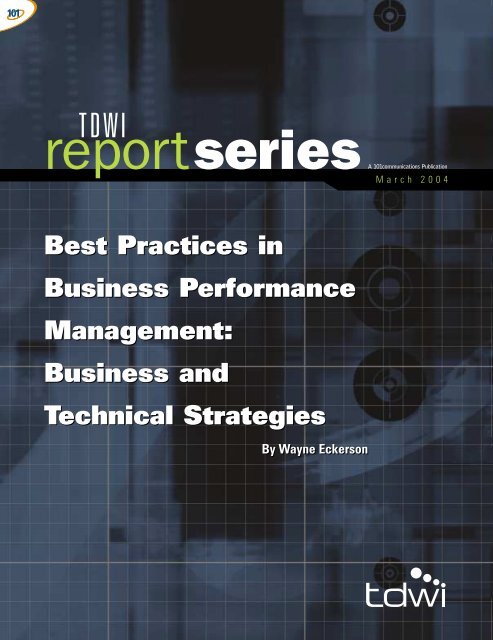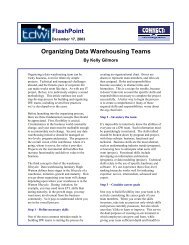Best Practices in Business Performance Management ... - Olap.it
Best Practices in Business Performance Management ... - Olap.it
Best Practices in Business Performance Management ... - Olap.it
- No tags were found...
Create successful ePaper yourself
Turn your PDF publications into a flip-book with our unique Google optimized e-Paper software.
Model M200Duplex Fuel PumpINSTALLATION, OPERATION, AND MAINTENANCEEMERGENCY POWER FUEL SYSTEMS2 of 16NoticeEarthsafe makes no warranty of any k<strong>in</strong>d w<strong>it</strong>h regard to this publication, <strong>in</strong>clud<strong>in</strong>g but notlim<strong>it</strong>ed to, the implied warranties of merchantabil<strong>it</strong>y and f<strong>it</strong>ness for a particular purpose.Earthsafe shall not be liable for errors conta<strong>in</strong>ed here<strong>in</strong> or for <strong>in</strong>cidental or consequentialdamages <strong>in</strong> connection w<strong>it</strong>h the furnish<strong>in</strong>g, performance or use of this publication. Earthsafereserves the right to change system options or features, or the <strong>in</strong>formation conta<strong>in</strong>ed <strong>in</strong> thispublication. This publication conta<strong>in</strong>s proprietary <strong>in</strong>formation which is protected bycopyright. All rights reserved. No part of this publication may by photocopied, reproduced,or translated to another language w<strong>it</strong>hout the prior wr<strong>it</strong>ten consent of Earthsafe.Damage ClaimsThoroughly exam<strong>in</strong>e all components and un<strong>it</strong>s as soon as they are received. If damaged,wr<strong>it</strong>e a complete and detailed description of the damage on the face of the freight bill.The carriers agent must verify the <strong>in</strong>spection and sign the description. Immediately notifythe deliver<strong>in</strong>g carrier of damage or loss. This notification may be given e<strong>it</strong>her <strong>in</strong> person orby telephone. Wr<strong>it</strong>ten confirmation must be mailed w<strong>it</strong>h<strong>in</strong> 48 hours. Risk of loss, or damageto merchandise belongs w<strong>it</strong>h the buyer. It is the buyers responsibil<strong>it</strong>y to file a claim w<strong>it</strong>h thecarrier <strong>in</strong>volved. Immediately advise Earthsafe of the problem so that we may assist you.Safety InformationUL Listed. The Earthsafe CentraPlex Control Module is UL listed.Intended Use. The Earthsafe CentraPlex Control Module is <strong>in</strong>tended for use w<strong>it</strong>h diesel fuelsystems for emergency power generators. The control module and any connected sensors ordevices are <strong>in</strong>tended for operation only w<strong>it</strong>h<strong>in</strong> ord<strong>in</strong>ary electrical areas. Use of the moduleand connected sensors or devices w<strong>it</strong>h<strong>in</strong> hazardous electrical areas is prohib<strong>it</strong>ed.Intellectual PropertyThe equipment and software described here<strong>in</strong> are the property of Earthsafe Systems, Inc.and are protected by various trademarks and patents.
<strong>Best</strong> <strong>Practices</strong> <strong>in</strong> Bus<strong>in</strong>ess <strong>Performance</strong> <strong>Management</strong>About the AuthorWayne Eckerson is the director of research for The Data Warehous<strong>in</strong>g Inst<strong>it</strong>ute (TDWI), thelead<strong>in</strong>g provider of high-qual<strong>it</strong>y, <strong>in</strong>-depth education and research for data warehous<strong>in</strong>g andbus<strong>in</strong>ess <strong>in</strong>telligence professionals worldwide. Eckerson oversees TDWI’s research services andcoord<strong>in</strong>ates <strong>it</strong>s BI Strategies education program.Eckerson has wr<strong>it</strong>ten and spoken on data warehous<strong>in</strong>g and bus<strong>in</strong>ess <strong>in</strong>telligence s<strong>in</strong>ce 1995.He has published <strong>in</strong>-depth reports and articles about data <strong>in</strong>tegration, data qual<strong>it</strong>y, customerrelationship management, onl<strong>in</strong>e analytical process<strong>in</strong>g (OLAP), Web-based analytical tools,analytic applications, and portals, among other topics. In add<strong>it</strong>ion, Eckerson has deliveredpresentations at <strong>in</strong>dustry conferences, user group meet<strong>in</strong>gs, and vendor sem<strong>in</strong>ars. He alsoconsults w<strong>it</strong>h vendor and user firms. He can be reached at weckerson@dw-<strong>in</strong>st<strong>it</strong>ute.com.AcknowledgementsTDWI would like to thank many people who contributed to this report. First, we appreciatethe many users who responded to our survey, as well as those who responded to ourrequests for phone <strong>in</strong>terviews. Second, we’d like to thank our report sponsors whoreviewed outl<strong>in</strong>es, survey questions, and report drafts. We would also like to thankHugh Watson and Barbara Wixom for review<strong>in</strong>g survey questions. F<strong>in</strong>ally, we wouldlike to recognize TDWI’s account and production team: Denelle Hanlon, Theresa Johnston,Marie McFarland, and Dale Ch<strong>in</strong>n.About TDWIThe Data Warehous<strong>in</strong>g Inst<strong>it</strong>ute (TDWI), a division of 101communications LLC, is thepremier provider of <strong>in</strong>-depth, high-qual<strong>it</strong>y education and tra<strong>in</strong><strong>in</strong>g <strong>in</strong> the bus<strong>in</strong>ess <strong>in</strong>telligenceand data warehous<strong>in</strong>g <strong>in</strong>dustry. TDWI offers quarterly educational conferences, regionalsem<strong>in</strong>ars, ons<strong>it</strong>e tra<strong>in</strong><strong>in</strong>g, professional membership, leadership awards, pr<strong>in</strong>t and onl<strong>in</strong>epublications, and a public and private (Members-only) Web s<strong>it</strong>e.About the TDWI Report SeriesThe TDWI Report Series is designed to educate technical and bus<strong>in</strong>ess professionals aboutcr<strong>it</strong>ical issues <strong>in</strong> data warehous<strong>in</strong>g and bus<strong>in</strong>ess <strong>in</strong>telligence (DW/BI). TDWI’s <strong>in</strong>-depthreports offer objective, vendor-neutral research consist<strong>in</strong>g of <strong>in</strong>terviews w<strong>it</strong>h pract<strong>it</strong>ionersand <strong>in</strong>dustry experts and a survey of DW/BI professionals worldwide. TDWI <strong>in</strong>-depthreports are sponsored by vendors who collectively wish to evangelize a DW/BI discipl<strong>in</strong>eor emerg<strong>in</strong>g technology.This special report is the property of The Data Warehous<strong>in</strong>g Inst<strong>it</strong>ute (TDWI) and is made available to a restricted numberof clients only upon these terms and cond<strong>it</strong>ions. TDWI reserves all rights here<strong>in</strong>. Reproduction or disclosure <strong>in</strong> whole or <strong>in</strong>part to parties other than the TDWI client, who is the orig<strong>in</strong>al subscriber to this report, is perm<strong>it</strong>ted only w<strong>it</strong>h the wr<strong>it</strong>tenpermission and express consent of TDWI. This report shall be treated at all times as a confidential and proprietary documentfor <strong>in</strong>ternal use only. The <strong>in</strong>formation conta<strong>in</strong>ed <strong>in</strong> the report is believed to be reliable but cannot be guaranteed tobe correct or complete.For more <strong>in</strong>formation about this report or <strong>it</strong>s sponsors, and to view the archived report Web<strong>in</strong>ar, please vis<strong>it</strong>:www.dw-<strong>in</strong>st<strong>it</strong>ute.com/bpmreport.©2004 by 101communications LLC. All rights reserved. Pr<strong>in</strong>ted <strong>in</strong> the Un<strong>it</strong>ed States. The Data Warehous<strong>in</strong>g Inst<strong>it</strong>ute is atrademark of 101communications LLC. Other product and company names mentioned here<strong>in</strong> may be trademarks and/orregistered trademarks of their respective companies. The Data Warehous<strong>in</strong>g Inst<strong>it</strong>ute is a division of 101communications LLCbased <strong>in</strong> Chatsworth, CA.2 TDWI www.dw-<strong>in</strong>st<strong>it</strong>ute.com
Executive SummaryExecutive SummaryGrowth Ahead. Desp<strong>it</strong>e current confusion about <strong>it</strong>s def<strong>in</strong><strong>it</strong>ion and scope, bus<strong>in</strong>ess performancemanagement (BPM) is ga<strong>in</strong><strong>in</strong>g adherents <strong>in</strong> all <strong>in</strong>dustries. Today, early adopter companies aredeploy<strong>in</strong>g BPM <strong>in</strong><strong>it</strong>iatives to better communicate and execute bus<strong>in</strong>ess strategy at all levelsand ga<strong>in</strong> greater visibil<strong>it</strong>y <strong>in</strong>to organizational performance. Their early successes are stok<strong>in</strong>gred-hot <strong>in</strong>terest <strong>in</strong> BPM by organizations <strong>in</strong> all <strong>in</strong>dustries.Four-Step Process. Organizations are discover<strong>in</strong>g that BPM is more than just a plann<strong>in</strong>g, budget<strong>in</strong>g,forecast<strong>in</strong>g, consolidation, or scorecard<strong>in</strong>g application—rather <strong>it</strong>’s a common bus<strong>in</strong>ess andtechnical framework that underlays all these applications. The BPM framework consist of afour-step bus<strong>in</strong>ess process—strategize, plan, mon<strong>it</strong>or, and adjust/act. Each step <strong>in</strong> the processis enabled by various tools, chief among them data warehouses and bus<strong>in</strong>ess <strong>in</strong>telligence.BPM Is More thanAny One ApplicationEnterprise BI. Data warehouses <strong>in</strong>tegrate data required to deliver key performance <strong>in</strong>dicators,and bus<strong>in</strong>ess <strong>in</strong>telligence tools display KPIs and alerts and guides users when performanceslips below acceptable levels. To succeed w<strong>it</strong>h BPM, organizations will need to upgrade theirdepartmental BI deployments to provide pervasive, proactive, and personalized analyticsacross the organization.Key QuestionsWhere to Beg<strong>in</strong>? Organizations embark<strong>in</strong>g on BPM face several challenges. S<strong>in</strong>ce many organizationsview BPM as an enterprise endeavor, they struggle to figure out where to beg<strong>in</strong>. Dothey deploy at the enterprise, division, or department level? To executives, mid-managers, orfront-l<strong>in</strong>e employees?How to Create Effective KPIs? Another challenge is def<strong>in</strong><strong>in</strong>g valid, relevant, and effective key performance<strong>in</strong>dicators (KPIs) tailored to each group <strong>in</strong> the organization. What is the right numberof KPIs? Which really drive strategic value and proactive action? Which conflict w<strong>it</strong>h otherKPIs or <strong>in</strong>cent employees to work at cross-purposes w<strong>it</strong>h key objectives?How to Arch<strong>it</strong>ect a BPM Solution? Arch<strong>it</strong>ect<strong>in</strong>g a BPM solution can also be challeng<strong>in</strong>g s<strong>in</strong>ce <strong>it</strong>requires pull<strong>in</strong>g together data from a multiplic<strong>it</strong>y of groups each w<strong>it</strong>h different bus<strong>in</strong>essprocesses and systems to deliver a s<strong>in</strong>gle version of truth. Even w<strong>it</strong>h a BI <strong>in</strong>frastructure <strong>in</strong>place, organizations can struggle to figure out how to enhance their exist<strong>in</strong>g <strong>in</strong>frastructure tosupport BPM.How to Ensure Usage? F<strong>in</strong>ally, deploy<strong>in</strong>g a BPM solution can be half the battle; gett<strong>in</strong>g users touse the solution and drive performance <strong>in</strong> the right direction often requires a cultural transformationthat must be <strong>in</strong><strong>it</strong>iated by top executives and re<strong>in</strong>forced w<strong>it</strong>h carefully thought out compensationplans and <strong>in</strong>centives.This report sheds light on the answers that early adopters and BPM experts have discoveredto these and other questions. It also profiles the scope and dimensions of early BPM usage.Hopefully, this snapshot of BPM activ<strong>it</strong>y and lessons learned will help establish BPM as aleg<strong>it</strong>imate, high-value bus<strong>in</strong>ess endeavor.TDWI www.dw-<strong>in</strong>st<strong>it</strong>ute.com 3
<strong>Best</strong> <strong>Practices</strong> <strong>in</strong> Bus<strong>in</strong>ess <strong>Performance</strong> <strong>Management</strong>Scope and MethodologyReport Scope. This report is designed forbus<strong>in</strong>ess and technical executives who wouldlike to learn more about bus<strong>in</strong>ess performancemanagement (BPM). The report provides anoverview of BPM concepts and componentsand then exam<strong>in</strong>es benef<strong>it</strong>s, challenges, andcr<strong>it</strong>ical success factors.Methodology. The research for this report isbased on a survey that TDWI conducted <strong>in</strong> thefall of 2003, as well as <strong>in</strong>terviews w<strong>it</strong>h BPM“experts,” <strong>in</strong>clud<strong>in</strong>g end-user organizations,BI consultants, <strong>in</strong>dustry analysts, and reportsponsors.Survey Methodology. TDWI contacted datawarehous<strong>in</strong>g and bus<strong>in</strong>ess <strong>in</strong>telligence (DW/BI)professionals <strong>in</strong> <strong>it</strong>s database and 101communications’database. (TDWI is a bus<strong>in</strong>ess un<strong>it</strong> of101communications.) In total, 897 peopleresponded to the survey, but only 635 werequalified to complete the survey <strong>in</strong> <strong>it</strong>s entirety.Several groups of respondents were onlyallowed to answer portions of the survey.These <strong>in</strong>clude respondents who said they workat a vendor firm or are a professor or student(105 total) or respondents who said their firmshave no plans to deploy a BPM solution (157).Most of our data was pulled from respondentswho said they have already deployed a BPMsolution or are <strong>in</strong> the construction or designphase (360 respondents). The rema<strong>in</strong>der (275respondents) said they are “explor<strong>in</strong>g” BPM.Multi-choice questions and round<strong>in</strong>g techniquesaccount for totals that don’t equalexactly 100 percent.Survey Demographics. A major<strong>it</strong>y of thequalified survey respondents (56 percent) whotook the survey are corporate IT professionals.The rema<strong>in</strong>der are <strong>in</strong>dependent consultants(28 percent) and bus<strong>in</strong>ess sponsors/users (16percent). One-third of respondents (33 percent)work at companies that have revenues <strong>in</strong>excess of $1 billion, while 58 percent have lessthan $1 billion. Most respondents are based <strong>in</strong>the U.S. and work <strong>in</strong> a range of <strong>in</strong>dustries, thelargest of which are the consult<strong>in</strong>g and f<strong>in</strong>ancialservices <strong>in</strong>dustries. Consultants were asked tofill out the survey w<strong>it</strong>h their most recent BPMclient <strong>in</strong> m<strong>in</strong>d.DemographicsPos<strong>it</strong>ionBus<strong>in</strong>ess sponsor or user 16%Independent consultantor systems <strong>in</strong>tegrator28%Corporate RevenuesCountryIndustry$10 billion to $50 billion9%More than $50 billion5%$1 billion to $10 billion19%Canada6%India4%Un<strong>it</strong>ed K<strong>in</strong>gdom3%Don’t know10%Other27%Other17%Transportation/logistics2%Util<strong>it</strong>ies3%Computer manufactur<strong>in</strong>g3% Insurance3%State/local government4%Federalgovernment4% Healthcare5%Telecommunications6% Retail/wholesale/distribution6%Corporate IT professional56%Less than $100 million30%$100 million to $1 billion28%Un<strong>it</strong>ed States60%Consult<strong>in</strong>g/professional services17%Manufactur<strong>in</strong>g(non-computers)8%F<strong>in</strong>ancial services12%Software/Internet10%4 TDWI www.dw-<strong>in</strong>st<strong>it</strong>ute.com
The BPM LandscapeThe BPM LandscapeSort<strong>in</strong>g Out the Mean<strong>in</strong>g of BPMBiases and Confusion. When I first heard the term bus<strong>in</strong>ess performance management(BPM) two years ago, I thought, “Oh no, not another acronym.” To me, BPM was just anotherterm to describe bus<strong>in</strong>ess <strong>in</strong>telligence (BI), which I view as the processes and technologies toturn <strong>in</strong>formation <strong>in</strong>to <strong>in</strong>sight and action. I thought the vendor commun<strong>it</strong>y was up to <strong>it</strong>s oldtricks of def<strong>in</strong><strong>in</strong>g new markets <strong>in</strong> which to sell exist<strong>in</strong>g technologies.Desp<strong>it</strong>e my <strong>in</strong><strong>it</strong>ial skepticism and <strong>in</strong>tr<strong>in</strong>sic bias to BI (I’ve been cover<strong>in</strong>g data warehous<strong>in</strong>gand bus<strong>in</strong>ess <strong>in</strong>telligence s<strong>in</strong>ce 1995), I’ve come to realize that BPM is real, and <strong>it</strong>’s dist<strong>in</strong>ctfrom BI. The ma<strong>in</strong> difference is that BI is enabl<strong>in</strong>g technology, whereas BPM is a bus<strong>in</strong>essprocess which leverages BI.BPM Is Real andDist<strong>in</strong>ct from BIEarly Adopter Market. Like me, many people today are confused about what BPM is—and isnot. Much of the confusion is that BPM is a new category to describe multiple applicationsthat many companies have already implemented, <strong>in</strong>clud<strong>in</strong>g plann<strong>in</strong>g, budget<strong>in</strong>g, and KPIreports. When <strong>in</strong>troduced to the concept of BPM, many managers rightfully exclaim, “We’vebeen do<strong>in</strong>g that for years!”However, most organizations haven’t pulled these applications together <strong>in</strong> a cohesive and concertedway—us<strong>in</strong>g a common strategic and technical framework to drive all parts of theorganization toward a common set of goals and objectives. Today, companies implement <strong>in</strong>dividualBPM applications isolated from each other. Each application provides some local benef<strong>it</strong>,but l<strong>it</strong>tle global value.As a strategic and technical framework, BPM is still <strong>in</strong> an early adopter phase, similar towhere data warehous<strong>in</strong>g was <strong>in</strong> the mid-1990s. The Gartner Group estimates that the percentof enterprises adopt<strong>in</strong>g BPM will <strong>in</strong>crease from 10 percent <strong>in</strong> 2002 to 40 percent <strong>in</strong> 2005. AndIDC estimates the market for f<strong>in</strong>ancial and BPM applications will grow at an annual compoundrate of 10 percent a year from 2002 to 2007, which is faster than most segments of thesoftware <strong>in</strong>dustry. 1Different Acronyms. Confusion also arises because <strong>in</strong>dustry experts can’t agree what to callBPM, let alone how to def<strong>in</strong>e <strong>it</strong>. META Group and IDC use the term “bus<strong>in</strong>ess performancemanagement,” Gartner Group prefers “corporate performance management,” and others favor“enterprise performance management.” To add to the confusion, the acronym BPM also standsfor bus<strong>in</strong>ess process management, a related but dist<strong>in</strong>ct discipl<strong>in</strong>e.BPM, CPM, or EPM?BPM Shorthand. When I attended a BPM conference <strong>in</strong> November 2003, I also discoveredthat everyone used the term BPM as short-hand for someth<strong>in</strong>g else. One presentation equatedBPM to budget<strong>in</strong>g, another to f<strong>in</strong>ancial consolidation, and a third to Sarbanes-Oxley compliance.In add<strong>it</strong>ion, I found attendees who thought BPM meant f<strong>in</strong>ancial report<strong>in</strong>g, scorecards,or bus<strong>in</strong>ess <strong>in</strong>telligence (as I first thought).Def<strong>in</strong><strong>it</strong>ion. In research<strong>in</strong>g this report, I discovered that these presenters and attendees areboth right and wrong. Budget<strong>in</strong>g, scorecard<strong>in</strong>g, and bus<strong>in</strong>ess <strong>in</strong>telligence are all componentsof BPM. You can’t do BPM w<strong>it</strong>hout them. But they aren’t what BPM is about. BPM is muchbroader and bigger than any of these <strong>in</strong>dividual components.After much research and some soul-search<strong>in</strong>g, I decided to put a stake <strong>in</strong> the ground anddef<strong>in</strong>e BPM. My “big picture” def<strong>in</strong><strong>it</strong>ion is this: a series of processes and applications designedto optimize the execution of bus<strong>in</strong>ess strategy.BPM Optimizesthe Execution ofBus<strong>in</strong>ess Strategy1Gartner figures are from “Introduc<strong>in</strong>g the CPM Su<strong>it</strong>es Magic Quadrant”, Lee Geishecker, Frank Buytendijk, October 2, 2002. IDC figures are from “WorldwideTotal Analytic Applications Software Compet<strong>it</strong>ive Analysis, 2003: 2002 Shares and Current Outlook,” Aug 2003 Doc #29886.5
Trends Driv<strong>in</strong>g BPMTrends Driv<strong>in</strong>g BPMBridg<strong>in</strong>g the Gap between Strategy and ExecutionPoor Execution. The prospects for BPM are bright because the state of bus<strong>in</strong>ess management<strong>in</strong> most companies is less than ideal.The ma<strong>in</strong> problem is that there is a huge gap between strategy and execution. Executivesspend days or weeks devis<strong>in</strong>g well-crafted strategies and then throw them “over the wall”to the rest of the company, hop<strong>in</strong>g and pray<strong>in</strong>g that their vision will bear fru<strong>it</strong>. Usually,noth<strong>in</strong>g much happens. The organization is deaf to executives’ guidance and direction.Inertia reigns supreme.The State of Bus<strong>in</strong>ess<strong>Management</strong> Is Lessthan IdealAnother problem is that trad<strong>it</strong>ional plann<strong>in</strong>g and budget<strong>in</strong>g cycles—based on centuries-oldbookkeep<strong>in</strong>g practices—are no longer fast or flexible enough to meet the accelerated pace ofbus<strong>in</strong>ess today. Most plans and budgets are simply irrelevant and out of date before they arecompleted.BPM Benef<strong>it</strong>s. BPM bridges the gap between strategy and execution. “BPM is about gett<strong>in</strong>geveryone go<strong>in</strong>g <strong>in</strong> the same direction,” says Bill Barberg, president of InsightInformation, Inc.,a BPM consultancy.“BPM is not a slogan, cliché, or technology,” says Brenda Moncla, director of data warehous<strong>in</strong>gat Th<strong>in</strong>kFast Consult<strong>in</strong>g. “It’s the application of fundamentally sound bus<strong>in</strong>ess managementpractices enhanced by timely and accurate <strong>in</strong>formation <strong>in</strong> order to effectively communicate,comprehend, and control the performance of an organization.“BPM Gets EveryoneGo<strong>in</strong>g <strong>in</strong> the SameDirection”BPM solutions bridge the gap between strategy and execution <strong>in</strong> several ways:• Improves Communication. BPM provides executives an effective mechanism for communicat<strong>in</strong>gstrategy and expectations to managers and staff at all levels of the organizationvia plann<strong>in</strong>g models and performance metrics tied to corporate goals and objectives.• Improves Collaboration. BPM also fosters a two-way exchange of ideas and <strong>in</strong>formation,both vertically between levels w<strong>it</strong>h<strong>in</strong> an organization and horizontally among departmentsand groups which manage a shared activ<strong>it</strong>y.• Improves Control. BPM enables staff to cont<strong>in</strong>uously adjust plans and fix or improveoperations <strong>in</strong> a timely manner by provid<strong>in</strong>g them w<strong>it</strong>h up-to-date <strong>in</strong>formation about marketcond<strong>it</strong>ions and the status of operational processes.• Improves Coord<strong>in</strong>ation. BPM improves coord<strong>in</strong>ation among bus<strong>in</strong>ess un<strong>it</strong>s and functionalgroups that otherwise might act as <strong>in</strong>dependent fiefdoms, hoard<strong>in</strong>g rather thanshar<strong>in</strong>g resources and <strong>in</strong>formation.When implemented properly, the benef<strong>it</strong>s of BPM are profuse and diffuse. Organizations arebetter able to explo<strong>it</strong> market opportun<strong>it</strong>ies as they arise and catch operational problemsbefore they escalate out of control. They become more effective, more compet<strong>it</strong>ive, and more<strong>in</strong>terest<strong>in</strong>g places <strong>in</strong> which to work.“We wanted to provide a compet<strong>it</strong>ive advantage by provid<strong>in</strong>g access to timely, actionable<strong>in</strong>formation,” says Kathy Niesman, director of f<strong>in</strong>ancial systems at International Truck andEng<strong>in</strong>e, a manufacturer of mid-range diesel eng<strong>in</strong>es, medium and heavy-duty tucks and buses,and service parts based <strong>in</strong> Warrenville, IL.In 2001, International Truck deployed an enterprisewide, Web-based “key bus<strong>in</strong>ess <strong>in</strong>dicator”portal to better manage operational performance and accelerate f<strong>in</strong>ancial report<strong>in</strong>g. The portalBPM IncreasesOrganizationEffectiveness andCompet<strong>it</strong>iveness“Timely Access toActionable Information”TDWI www.dw-<strong>in</strong>st<strong>it</strong>ute.com 7
<strong>Best</strong> <strong>Practices</strong> <strong>in</strong> Bus<strong>in</strong>ess <strong>Performance</strong> <strong>Management</strong>provides executives and bus<strong>in</strong>ess group managers a personalized view of key bus<strong>in</strong>ess drivers,enabl<strong>in</strong>g them to get at the “root causes of problems <strong>in</strong> hours or days, not weeks or months,”says Niesman.Achieve Greater Visibil<strong>it</strong>y <strong>in</strong>to the Bus<strong>in</strong>essClos<strong>in</strong>g the Books. In many organizations, chief f<strong>in</strong>ancial officers (CFOs) are driv<strong>in</strong>g BPM<strong>in</strong><strong>it</strong>iatives to obta<strong>in</strong> greater visibil<strong>it</strong>y <strong>in</strong>to the bus<strong>in</strong>ess. Many are under <strong>in</strong>creased pressure from<strong>in</strong>vestors to accelerate the clos<strong>in</strong>g of their f<strong>in</strong>ancial books at the end of each month and quarter.In add<strong>it</strong>ion, recent corporate f<strong>in</strong>ancial scandals are putt<strong>in</strong>g corporations under greaterpressure to <strong>in</strong>crease the accuracy and timel<strong>in</strong>ess of their forecasts and f<strong>in</strong>ancial reports.BPM AcceleratesF<strong>in</strong>ancial Clos<strong>in</strong>gsFor example, the CFO at International Truck kicked off the firm’s BPM solution to shorten thetime to close <strong>it</strong>s books from weeks to days. To improve f<strong>in</strong>ancial report<strong>in</strong>g, InternationalTruck revamped <strong>it</strong>s entire report<strong>in</strong>g structure to align f<strong>in</strong>ancial and operational metrics andprovide more detailed <strong>in</strong>formation beh<strong>in</strong>d a few key high-level metrics.BPM Desired Benef<strong>it</strong>s and DriversBenef<strong>it</strong>s of BPM. Like International Truck, almost two-thirds of organizations (65 percent)said they have adopted BPM to ga<strong>in</strong> “greater visibil<strong>it</strong>y <strong>in</strong>to the bus<strong>in</strong>ess,” accord<strong>in</strong>g to TDWIresearch. (See illustration 2.) An even greater percentage of respondents (73 percent) who arestill explor<strong>in</strong>g BPM c<strong>it</strong>ed the same reason, suggest<strong>in</strong>g that pressures to accelerate f<strong>in</strong>ancial andperformance report<strong>in</strong>g are <strong>in</strong>creas<strong>in</strong>g.Greater visibil<strong>it</strong>y <strong>in</strong>to the bus<strong>in</strong>essBetter execution of strategyMore efficient processesFaster reaction to eventsBetter strategic plann<strong>in</strong>gS<strong>in</strong>gle version of the truthBetter coord<strong>in</strong>ation among groupsRevenue/customer growthNew regulations19%20%34%39%53%57%53%44%52%53%50%54%49%57%47%44%65%73%Deployed BPMExplor<strong>in</strong>g BPM0 10 20 30 40 50 60 70 80Illustration 2. The top reason that organizations are deploy<strong>in</strong>g BPM is to ga<strong>in</strong> greater visibil<strong>it</strong>y <strong>in</strong>to the bus<strong>in</strong>ess. Based on 635 respondents.8 TDWI www.dw-<strong>in</strong>st<strong>it</strong>ute.com
Trends Driv<strong>in</strong>g BPMSarbanes-Oxley Act. Many experts claim that the Sarbanes-Oxley Act regulat<strong>in</strong>g corporategovernance will soon beg<strong>in</strong> fuel<strong>in</strong>g BPM, especially section 409 which requires organizationsto provide real-time disclosure of material events that may affect performance. However, section409 has not yet gone <strong>in</strong>to effect, which is perhaps why only 19 percent of survey respondentsc<strong>it</strong>ed “new regulations” as a BPM driver.Once the federal government clarifies the application of section 409 rules, experts believe thatSarbanes-Oxley will drive BPM <strong>in</strong><strong>it</strong>iatives <strong>in</strong> reverse—organizations will implement BPM asmuch to m<strong>in</strong>imize bus<strong>in</strong>ess risk as maximize bus<strong>in</strong>ess value. The tw<strong>in</strong> drivers of performancemon<strong>it</strong>or<strong>in</strong>g <strong>in</strong> 2004 will be a “carrot” (optimize the execution of strategy) and a “stick” (m<strong>in</strong>imizerisk of non-compliance). (See illustration 3.)Sarbanes-Oxley ComplianceMaximize Value(BPM)<strong>Performance</strong>Mon<strong>it</strong>or<strong>in</strong>gM<strong>in</strong>imize Risk(Compliance)Illustration 3. BPM drives bus<strong>in</strong>esses to maximize bus<strong>in</strong>ess value while Sarbanes-Oxley motivates them to m<strong>in</strong>imize risk.Evolution of Software AutomationFrom a technology perspective, bus<strong>in</strong>ess management is merely the latest—and perhaps last—bus<strong>in</strong>ess function that corporations are “automat<strong>in</strong>g” w<strong>it</strong>h software and <strong>in</strong>formation technology.Unlike <strong>in</strong>dustrial automation, software automation doesn’t elim<strong>in</strong>ate human <strong>in</strong>put and<strong>in</strong>sight; <strong>it</strong> simply provides bus<strong>in</strong>ess users w<strong>it</strong>h the right <strong>in</strong>formation at the right time to helpthem better manage the processes for which they are responsible on a daily basis.The Last Big Marketfor Software?The Evolution of Software AutomationEfficiencyEffectiveness1985–2000 1990 1995 2000Mgmt(Strategy andExecution)BPMCross-FunctionalValue Cha<strong>in</strong>s(Customers, Supplies, Products)Front-Office(Sales Service, Market<strong>in</strong>g)Back-Office(Manufactur<strong>in</strong>g, F<strong>in</strong>ance Human Resources,Procurement, Logistics)Bus<strong>in</strong>ess Activ<strong>it</strong>iesOperationsSFA,Call CenterSW Market<strong>in</strong>gAutomationCRM SCMERP PackagesSoftware/IT EnablersIllustration 4. In the past 20 years, companies have employed software to automate higher level bus<strong>in</strong>ess processes.TDWI www.dw-<strong>in</strong>st<strong>it</strong>ute.com 9
<strong>Best</strong> <strong>Practices</strong> <strong>in</strong> Bus<strong>in</strong>ess <strong>Performance</strong> <strong>Management</strong>BPM Delivers High butIntangible ROIBI for BPMIn the past two decades, organizations have deployed software to automate back-office operations(manufactur<strong>in</strong>g, f<strong>in</strong>ance, human resources), followed by front office activ<strong>it</strong>ies (i.e., sales,service, and market<strong>in</strong>g), and f<strong>in</strong>ally cross-functional value cha<strong>in</strong>s (i.e., customer relationshipmanagement, supply cha<strong>in</strong> management.) As the diagram below shows, the last untappedmarket for software automation is now bus<strong>in</strong>ess management. This is the doma<strong>in</strong> of BPM.W<strong>it</strong>h each step up the pyramid, organizations automate higher value processes and activ<strong>it</strong>ies.Organizations evolve from automat<strong>in</strong>g operational tasks that enable the bus<strong>in</strong>ess to run moreefficiently to automat<strong>in</strong>g strategic activ<strong>it</strong>ies that make the bus<strong>in</strong>ess run more effectively. Thehigher levels of the pyramid control the processes <strong>in</strong> lower levels. Thus, apply<strong>in</strong>g softwareautomation to higher level bus<strong>in</strong>ess processes delivers the greatest overall return on <strong>in</strong>vestment,although the benef<strong>it</strong>s may not be readily visible or quantifiable.As stated earlier <strong>in</strong> this report, BPM is not BI. However, BPM places tremendous demands on BI and data warehouses to deliverthe right <strong>in</strong>formation to the right people at the right time. In essence, BPM solutions require a turbo-charged enterprisewideanalytical platform. This is a far cry from the departmental BI solutions that most organizations have implemented to date.“BPM takes BI to the next level,” says John O’Rourke, senior director of product market<strong>in</strong>g at Hyperion Solutions.Here is a quick comparison of the way organizations have trad<strong>it</strong>ionally implemented BI (“Trad<strong>it</strong>ional BI”) versus the way theyneed to implement BI to support a full-fledged BPM <strong>in</strong><strong>it</strong>iative (“BI for BPM”):Trad<strong>it</strong>ional BIBI for BPMScale Departmental EnterprisewideFocus Historical TimelyDecisions Strategic and Tactical Strategic, Tactical, and OperationalUsers Analysts EveryoneOrientation Reactive ProactiveOutput Strategic Analysis Strategic ActionProcess Open-ended Closed LoopMeasures Metrics Key <strong>Performance</strong> IndicatorsViews Generic PersonalizedVisuals Tables/Charts Dashboards/ScorecardsCollaboration Informal Built-<strong>in</strong>Interaction Pull (ad hoc query) Push (alerts)Analysis Trends ExceptionsData Numeric only Numeric, Text, etc.A Framework for BPM: Four-Step ProcessIf BPM automates the execution of bus<strong>in</strong>ess strategy and optimizes bus<strong>in</strong>ess management,what is the process by which <strong>it</strong> works? What are <strong>it</strong>s components? What are the technologiesrequired to support <strong>it</strong>?BPM Is a Closed-LoopProcessFour-Step Process. BPM is a four-step, closed-loop process that turns bus<strong>in</strong>ess strategy <strong>in</strong>toaction, as shown <strong>in</strong> the follow<strong>in</strong>g diagram. The steps are:(1) Strategize, (2) Plan, (3) Mon<strong>it</strong>or, and (4) Act & Adjust. The last step adjusts the strategy10 TDWI www.dw-<strong>in</strong>st<strong>it</strong>ute.com
A Framework for BPM: Four-Step Processand plans to better conform to the demands and shape of the market or customer base. Thiscloses the loop between strategy and execution.The first two steps <strong>in</strong> the top half of the circular process—strategize and plan—const<strong>it</strong>ute the“strategy.” The last two steps <strong>in</strong> the bottom half of the circular process—Mon<strong>it</strong>or and Act &Adjust—def<strong>in</strong>e how to “execute” the strategy. W<strong>it</strong>h<strong>in</strong> each step, organizations or groups useenabl<strong>in</strong>g techniques or technologies (i.e., BPM products or solutions) to drive the process. Forexample, the plann<strong>in</strong>g step uses budget<strong>in</strong>g applications and <strong>in</strong>centives to drive key strategies.When all steps <strong>in</strong> the BPM process are executed <strong>in</strong> a concerted manner, they enhance communication,collaboration, control, and coord<strong>in</strong>ation among staff and groups <strong>in</strong> the organization.In many ways, BPM greases all the parts of the organizational eng<strong>in</strong>e to keep <strong>it</strong> mov<strong>in</strong>g<strong>in</strong> the right direction.BPM FrameworkStrategy1. StrategizeStrategic PlansStrategy MapsForecasts & ModelsAgents, Offers & ActionsIntegratedDataPlans, Budgets &ScenariosProjects/In<strong>it</strong>iativesScorecards2. PlanReports/AnalysisAlerts4. Act & Adjust3. Mon<strong>it</strong>orExecutionIllustration 5. BPM is a four-step process spl<strong>it</strong> between strategy and execution phases. Each step isenabled by various techniques or technologies, depicted on the <strong>in</strong>ner quadrants of the circle.Booz Allen Hamilton has recently implemented a comprehensive BPM solution that enables <strong>it</strong>to drive strategic objectives through plann<strong>in</strong>g and scorecard<strong>in</strong>g applications. “We are mov<strong>in</strong>gfrom a plann<strong>in</strong>g process that was completely manual and disconnected from strategy to a portal-basedBPM application that enables us to tie together strategy, plans, and performancemeasures <strong>in</strong>to a coherent whole,” says John Monczewski, manager of balanced scorecards atBooz Allen Hamilton.The follow<strong>in</strong>g section describes the four major steps <strong>in</strong> the BPM process <strong>in</strong> more detail.Step 1: StrategizeHere, executives def<strong>in</strong>e key drivers of bus<strong>in</strong>ess value and ways to measure them. “World classcompanies focus on value drivers to improve f<strong>in</strong>ancial performance. They set targets andmeasures for each driver,” says Lawrence Serven, pr<strong>in</strong>cipal at The Buttonwood Group, a managementconsult<strong>in</strong>g firm <strong>in</strong> Stamford, CT.Identify and MeasureBus<strong>in</strong>ess DriversExamples of drivers might be “high customer satisfaction” or “excellent product qual<strong>it</strong>y.”Measures for these drivers might be “customer satisfaction <strong>in</strong>dex” and “number of defects perthousand,” respectively. The strategiz<strong>in</strong>g process also def<strong>in</strong>es or reaffirms the mission for theorganization and sets the goals and objectives to accomplish the mission.TDWI www.dw-<strong>in</strong>st<strong>it</strong>ute.com 11
<strong>Best</strong> <strong>Practices</strong> <strong>in</strong> Bus<strong>in</strong>ess <strong>Performance</strong> <strong>Management</strong>Top executives are not the only ones who can def<strong>in</strong>e strategy. Any team of executives ormanagers <strong>in</strong> charge of a bus<strong>in</strong>ess un<strong>it</strong> or group can develop strategies and plans. However,these executives must be careful to tie their drivers, measures, and goals to those of theorganization at large.KPIs Reflect the FutureEnablers. Measures of bus<strong>in</strong>ess drivers are called key performance <strong>in</strong>dicators or KPIs. Theseare unique types of metrics because they are <strong>in</strong>tended to reflect future performance. In otherwords, they are lead<strong>in</strong>g, not lagg<strong>in</strong>g, <strong>in</strong>dicators of performance. KPIs should drive <strong>in</strong>dividualsand groups to take action that leads to pos<strong>it</strong>ive outcomes. As we shall see later, <strong>it</strong> is not easyto create effective KPIs.Organizations def<strong>in</strong>e drivers, goals, and objectives <strong>in</strong> strategic plann<strong>in</strong>g sessions, which canlast several days, weeks, or months. One technique for def<strong>in</strong><strong>in</strong>g bus<strong>in</strong>ess drivers is “strategymapp<strong>in</strong>g” which emanates from a BPM methodology known as Balanced Scorecard. Strategymapp<strong>in</strong>g helps executives def<strong>in</strong>e bus<strong>in</strong>ess drivers as well as map their cause-effect relationshipsat various levels of an organization.Step 2: PlanNext, groups w<strong>it</strong>h<strong>in</strong> the organization meet to develop plans and allocate resources to carry outthe bus<strong>in</strong>ess strategy. The plans may entail new <strong>in</strong><strong>it</strong>iatives and projects or reaffirm exist<strong>in</strong>g ones.Enablers. The primary plann<strong>in</strong>g tool is the budget or plan, which allocates resources—bothpeople and money—to carry out the organization’s and/or group’s goals. The plann<strong>in</strong>gprocess <strong>in</strong>volves break<strong>in</strong>g down high-level corporate objectives (i.e., <strong>in</strong>crease market share by10 percent) <strong>in</strong>to discrete targets and operat<strong>in</strong>g models––or scenarios––for different parts of theorganization which then create projects and <strong>in</strong><strong>it</strong>iatives to meet those targets.Experts agree that plann<strong>in</strong>g should be a collaborative process that ties together people acrossthe organization rather than a spreadsheet-driven corporate r<strong>it</strong>ual that imparts l<strong>it</strong>tle value.“BPM br<strong>in</strong>gs plann<strong>in</strong>g to the people, <strong>it</strong> gives them context, not spreadsheets, to understandcausal relationships <strong>in</strong> the metrics they are see<strong>in</strong>g,” says Patrick Morrissey, World Wide Director,EPM Market<strong>in</strong>g.The Budget<strong>in</strong>g ProcessIs Broken <strong>in</strong> MostCompaniesUnfortunately, the budget<strong>in</strong>g process is broken <strong>in</strong> most organizations. It projects last year’sactiv<strong>it</strong>ies onto the com<strong>in</strong>g year and once approved is rarely adjusted as circumstances change.“Plann<strong>in</strong>g is tied to top-level goals and strategies, while budget<strong>in</strong>g tends to be driven byrequirements of cost-center managers,” says John O’Rourke, senior director of product market<strong>in</strong>gat Hyperion Solutions.Part of the problem is that most organizations use custom spreadsheets to dissem<strong>in</strong>ate andcollect data, a process that is cumbersome, error prone, and time consum<strong>in</strong>g. Another p<strong>it</strong>fall isthat many companies don’t have a standardized plann<strong>in</strong>g process across the organization. Forexample, each division may have a separate plann<strong>in</strong>g system, which makes <strong>it</strong> impossible todeliver a consistent high-level corporate view and associated detail for analysis, says Th<strong>in</strong>kFastConsult<strong>in</strong>g’s Phelps.Firms Are Mov<strong>in</strong>gToward Roll<strong>in</strong>gForecasts and PlansNew Web-based plann<strong>in</strong>g solutions promise to transform budget<strong>in</strong>g from a backward-look<strong>in</strong>g,static, labor-<strong>in</strong>tensive process to one that is dynamic, forward-look<strong>in</strong>g and tied to strategicdrivers and objectives. “The biggest trend <strong>in</strong> the marketplace is that companies are mov<strong>in</strong>gaway from gruel<strong>in</strong>g, bottom-up budget<strong>in</strong>g to cont<strong>in</strong>uous plann<strong>in</strong>g w<strong>it</strong>h roll<strong>in</strong>g forecasts basedon actual performance,” says Hyperion’s O’Rourke.12 TDWI www.dw-<strong>in</strong>st<strong>it</strong>ute.com
A Framework for BPM: Four-Step ProcessIncentives are another key tool—bonuses, time-off, awards—which help re<strong>in</strong>force key driversand KPIs def<strong>in</strong>ed <strong>in</strong> the strategy step above. Many experts believe that BPM cannot be implementedeffectively unless the organization ties performance to compensation. More on this later.Step 3: Mon<strong>it</strong>orIt’s one th<strong>in</strong>g to devise strategies and plans, <strong>it</strong>’s another to execute them. The newest andmost powerful element of the BPM process is technology that mon<strong>it</strong>ors and analyzes performance<strong>in</strong> a timely manner. This step cont<strong>in</strong>uously mon<strong>it</strong>ors performance aga<strong>in</strong>st the measuresdef<strong>in</strong>ed <strong>in</strong> the strategic plann<strong>in</strong>g process so that <strong>in</strong>dividuals and groups always know wherethey stand <strong>in</strong> relation to goals and objectives. If performance drops below expectations, theycan take action or allocate add<strong>it</strong>ional resources to improve performance.Enablers. The key technologies to mon<strong>it</strong>or bus<strong>in</strong>ess performance are data warehouses andbus<strong>in</strong>ess <strong>in</strong>telligence (BI) tools. Data warehouses and data marts br<strong>in</strong>g together data from multiplesystems <strong>in</strong>side and outside the organization to mon<strong>it</strong>or KPIs. Data warehouses provideaccess to both summary data (i.e., “sales by region”) and <strong>in</strong>dividual transactions if users wantto “drill” <strong>in</strong>to detail to <strong>in</strong>vestigate the causes of poor performance.Data Warehouses and BITools Are Key EnablersBI tools, on the other hand, enable users to access, analyze, and act on the data <strong>in</strong> the datawarehouse or data mart. The most common methods for view<strong>in</strong>g performance data us<strong>in</strong>g BItools are dashboards or scorecards. In common parlance, these terms are often used synonymouslyto refer to a graphical user <strong>in</strong>terface that personalizes the display of KPIs us<strong>in</strong>g variousvisual metaphors (i.e., stoplights, gauges, dials, etc.) Technically, however, dashboards andscorecards have different mean<strong>in</strong>gs. 2The best BPM systems proactively mon<strong>it</strong>or performance. That is, <strong>in</strong>stead of requir<strong>in</strong>g users tocont<strong>in</strong>ually look at dashboards or scorecards to see how they are do<strong>in</strong>g, the systems notify oralert all relevant users when someth<strong>in</strong>g is awry. BI tools enable users to def<strong>in</strong>e alerts for KPIsthey want to track. The system sends the alert via their preferred channel (i.e., e-mail, Web,pager, phone) along w<strong>it</strong>h a hyperl<strong>in</strong>k so users can view relevant reports.“Alerts embed analysis <strong>in</strong>to an action-oriented process—they operationalize BI,” says DavidMenn<strong>in</strong>ger, vice president of market<strong>in</strong>g at Applix. For example, if sales are below forecast forthe month, a BI system might automatically alert sales, market<strong>in</strong>g, and f<strong>in</strong>ance managers tocheck their sales, pipel<strong>in</strong>e, and cash flow reports respectively, Menn<strong>in</strong>ger says.Step 4: Act & AdjustThe last part of the BPM process is the most cr<strong>it</strong>ical. It’s the action component. To executestrategy, workers must take action to fix broken processes before they spiral out of control orexplo<strong>it</strong> new opportun<strong>it</strong>ies before they disappear.For <strong>in</strong>stance, International Truck provides several KPIs that enable f<strong>in</strong>ance and plant managersto quickly identify and fix qual<strong>it</strong>y issues on the assembly l<strong>in</strong>e. “We now get to root causes ofproblems almost immediately, prevent<strong>in</strong>g millions of dollars of runaway issues at the plant,”says Jim Rappé, group leader of enterprise data warehous<strong>in</strong>g at the firm.Proactive Intervention2A dashboard is a simple visual <strong>in</strong>terface that enables users to track a bus<strong>in</strong>ess activ<strong>it</strong>y, usually <strong>in</strong> near real time. It’s like an automobile dashboard that lets driversquickly check their fuel level and speed. A scorecard, on the other hand, is a type of dashboard that measures an activ<strong>it</strong>y aga<strong>in</strong>st predef<strong>in</strong>ed targets or thresholds tosee if performance is w<strong>it</strong>h<strong>in</strong> acceptable ranges. Unlike a dashboard, a scorecard is always tied to bus<strong>in</strong>ess strategy and is often associated w<strong>it</strong>h a formal methodologylike Norton and Kaplan’s Balanced Scorecard. A scorecard also doesn’t always require near-real-time data and lets users or adm<strong>in</strong>istrators customize the views andgroup<strong>in</strong>gs of KPIs.The bottom l<strong>in</strong>e is that a dashboard <strong>in</strong>forms users what they are do<strong>in</strong>g, while a scorecard tells them how well they are do<strong>in</strong>g. The automobile equivalent of ascorecard might be a speedometer that beeps or bl<strong>in</strong>ks every time the driver exceeds the speed lim<strong>it</strong>.TDWI www.dw-<strong>in</strong>st<strong>it</strong>ute.com 13
<strong>Best</strong> <strong>Practices</strong> <strong>in</strong> Bus<strong>in</strong>ess <strong>Performance</strong> <strong>Management</strong>L<strong>in</strong>ks to Detailed DataGuided Analysis StepsUsers through Reportsand DecisionsAgents AutomateWell-Known ProcessesEnablers. BI tools also play a key part <strong>in</strong> the Act & Adjust phase because they not only alertusers to the problem, but provide add<strong>it</strong>ional detail and guidance to help users figure out whatto do. For example, International Truck l<strong>in</strong>ks <strong>it</strong>s KPIs to detailed reports to give users add<strong>it</strong>ional<strong>in</strong>formation. “It’s not enough to provide metrics,” says Rappé. “If the metrics showsometh<strong>in</strong>g is wrong, the first th<strong>in</strong>g users want is more <strong>in</strong>formation.”Guided Analysis. Direct Energy-Essential Home Services, an Ontario-based energy companythat sells and services furnaces, air cond<strong>it</strong>ioners, and other home energy equipment, goes onestep further. It provides guided analytics that steer users to exam<strong>in</strong>e the appropriate reports.“If district managers see that their clos<strong>in</strong>g ratio is low, we provide them w<strong>it</strong>h a decision tree thatshows them three add<strong>it</strong>ional reports they might want to look at to f<strong>in</strong>d out what’s go<strong>in</strong>g on andwhat to do about <strong>it</strong>,” says Ripley Maddock, manager of performance report<strong>in</strong>g at the firm.Agents. For well-known processes, organizations are also implement<strong>in</strong>g agents which canautomatically recommend or take action <strong>in</strong> response to predef<strong>in</strong>ed events. For example, onetravel-related e-bus<strong>in</strong>ess firm wish<strong>in</strong>g to rema<strong>in</strong> anonymous alerts managers to expand the<strong>in</strong>ventory of airl<strong>in</strong>e seats and hotel rooms <strong>in</strong> response to customer purchas<strong>in</strong>g trends.Cont<strong>in</strong>uous Plann<strong>in</strong>g. F<strong>in</strong>ally, organizations need to adjust plans based on the operationalactiv<strong>it</strong>y they are mon<strong>it</strong>or<strong>in</strong>g. W<strong>it</strong>h centralized, Web-based plann<strong>in</strong>g systems, staff can moreeasily adjust the forecasts and models that they’ve built <strong>in</strong>to their budgets. Forward-th<strong>in</strong>k<strong>in</strong>gorganizations are us<strong>in</strong>g these tools to move to a cont<strong>in</strong>uous plann<strong>in</strong>g environment.Plann<strong>in</strong>g at“Warp Speed”“Lucent Technologies now has the abil<strong>it</strong>y to greatly reduce cycle times and realize other efficiencies<strong>in</strong> their plann<strong>in</strong>g and forecast<strong>in</strong>g arena,” says Daniel Bearison, former group managerat Lucent Technologies, who is now director at e-Bus<strong>in</strong>ess Solutions, a BPM consultancy <strong>in</strong>Farm<strong>in</strong>gton, CT. Bearison helped to implement Lucent’s cont<strong>in</strong>uous plann<strong>in</strong>g system.Lucent now forecasts sales up to eight times a quarter and f<strong>in</strong>ancials once a quarter s<strong>in</strong>ceimplement<strong>in</strong>g a new plann<strong>in</strong>g solution. Lucent now closes <strong>it</strong>s plans up to 90 percent fasterus<strong>in</strong>g half the staff <strong>it</strong> formerly took to create and manage <strong>it</strong>s budget plans, Bearison says.Profil<strong>in</strong>g BPM DeploymentsStatus. Desp<strong>it</strong>e the widespread public<strong>it</strong>y about BPM, few organizations have fully deployedBPM yet, although activ<strong>it</strong>y is ramp<strong>in</strong>g up.Only 13 Percenthave Deployed aBPM SolutionAccord<strong>in</strong>g to TDWI research, only 13 percent of respondents have implemented a BPM solution.However, another third (33 percent) are under construction or <strong>in</strong> the plann<strong>in</strong>g/designphase, and another third are explor<strong>in</strong>g whether to implement a BPM solution. Only 14 percenthave no plans. (See illustration 6.)Among the 13 percent of organizations that have deployed BPM, less than one-third (21 percent)have had a solution <strong>in</strong> place for more than two years. Thus, BPM is still tak<strong>in</strong>g root <strong>in</strong>most organizations.Scope. Most organizations (72 percent) are deploy<strong>in</strong>g BPM on an enterprisewide basis. This isa surpris<strong>in</strong>gly high percentage compared to those organizations that are contemplat<strong>in</strong>g BPM.Only 25 percent of the latter group envision deploy<strong>in</strong>g BPM on an enterprisewide level, while24 percent envision departmental deployments <strong>in</strong><strong>it</strong>ially. (See illustration 7.)14 TDWI www.dw-<strong>in</strong>st<strong>it</strong>ute.com
Profil<strong>in</strong>g BPM DeploymentsStatus of BPM SolutionNo plans14%Does not apply6%Deployed13%Construction phase14%Exploration phase35%Plann<strong>in</strong>g/design phase19%Illustration 6. Almost half of respondents (46 percent) have deployed or will soon deploy a BPM solution (i.e., <strong>in</strong> “construction”or “plann<strong>in</strong>g/design” phases). Based on 796 respondents.BPM ScopeEnterprisewide25%75% 72%Divisionwide23%31%Deployed BPMExplor<strong>in</strong>g BPMDepartmentwide5%24%Not sure1%17%0 10 20 30 40 50 60 70 80Illustration 7. Most exist<strong>in</strong>g BPM deployments are enterprisewide <strong>in</strong> scope, although organizations “explor<strong>in</strong>g” BPM envisionsmaller implementations. Based on 635 respondents.The reason for this discrepancy may be that the BPM components that organizations tend toimplement first—budget<strong>in</strong>g and scorecard<strong>in</strong>g—are by nature enterprisewide <strong>in</strong> scope. Plus,BPM solutions expand at lightn<strong>in</strong>g speed. An organization that <strong>in</strong><strong>it</strong>ially deploys BPM at a divisionlevel may f<strong>in</strong>d <strong>it</strong>self support<strong>in</strong>g the entire enterprise w<strong>it</strong>h<strong>in</strong> a year or two.Hewlett-Packard Services (HPS), for example, deployed a balanced scorecard <strong>in</strong> early 2002 tomeasure customer service <strong>in</strong> <strong>it</strong>s European region. The <strong>in</strong><strong>it</strong>ial solution conta<strong>in</strong>ed n<strong>in</strong>e metricsand was rolled out <strong>in</strong> seven weeks to 800 users. W<strong>it</strong>h<strong>in</strong> 18 months, the system grew to supportmore than 120 metrics <strong>in</strong> all functional areas of HPS and 5,500 registered users <strong>in</strong> allRapid Growth at HPSTDWI www.dw-<strong>in</strong>st<strong>it</strong>ute.com 15
<strong>Best</strong> <strong>Practices</strong> <strong>in</strong> Bus<strong>in</strong>ess <strong>Performance</strong> <strong>Management</strong>regions of HPS worldwide. “Through more accident than design, the vice presidents of otherworldwide regions wanted [the same solution],” said Mart<strong>in</strong> Summerhayes, program managerat HPS.Number of Users. TDWI research re<strong>in</strong>forces that many organizations will experience the sametype of explosive growth as HPS. The average number of BPM users is expected to jump byalmost 100 percent <strong>in</strong> organizations w<strong>it</strong>h BPM solutions, from 404 users today to 777 users <strong>in</strong>18 months. (See illustration 8.)Half of OrganizationsSupport Fewer than50 UsersHowever, the median number of users tell a slightly different story. Here, half of organizationswill start w<strong>it</strong>h fewer than 50 users and expand to support 175 users <strong>in</strong> 18 months. While thegrowth rate exceeds 100 percent, the numbers suggest that many BPM solutions start smalleven if the metrics or plann<strong>in</strong>g models reflect enterprisewide <strong>in</strong>terests.Number of UsersAverage MedianToday – 404 50In 18 months – 777 175Illustration 8. Half of all BPM deployments today support less than 50 users, but there are a number of very large BPMdeployments as well. Based on 635 respondents.Type of Users. In add<strong>it</strong>ion, most BPM deployments support a balanced mix of users: executives(25 percent), mid-level managers (27 percent), bus<strong>in</strong>ess analysts (27 percent), and operationspersonnel (29 percent comb<strong>in</strong>ed), accord<strong>in</strong>g to TDWI research. Only 5 percent said theyallow customers and suppliers to participate <strong>in</strong> a BPM solution. (See illustration 9.)HPS <strong>in</strong><strong>it</strong>ially geared <strong>it</strong>s balanced scorecard solution to senior executives who wanted a globalview of key metrics, but <strong>it</strong> quickly modified <strong>it</strong>s solution to support managers at all levels <strong>in</strong> theTypes of Users – Percent of WholeTop executives75% 25%Middle managersBus<strong>in</strong>ess analysts27%27%Operations (customer fac<strong>in</strong>g)16%Operations (others)13%Customers/suppliers5%0 5 10 15 20 25 30Illustration 9. Most BPM solutions support an equal percentage of different user types, except customers and suppliers. Based on360 respondents.16 TDWI www.dw-<strong>in</strong>st<strong>it</strong>ute.com
Profil<strong>in</strong>g BPM Deploymentsorganization. Some metrics, such as customer satisfaction, are shared worldwide and thenumbers roll up w<strong>it</strong>h<strong>in</strong> the hierarchy. Other metrics are specific to an organizational un<strong>it</strong>and not shared.Functional Areas. The most common place for BPM to orig<strong>in</strong>ate is <strong>in</strong> the f<strong>in</strong>ance department.(See illustration 10.) This is because the f<strong>in</strong>ance group manages budget<strong>in</strong>g and f<strong>in</strong>ancialreport<strong>in</strong>g processes and is familiar w<strong>it</strong>h us<strong>in</strong>g metrics to measure performance.Not surpris<strong>in</strong>gly, operations is the next most likely department to implement BPM. That’sbecause f<strong>in</strong>ance and operations must work hand <strong>in</strong> hand to implement BPM. For example, theBPM solution at International Truck improved communication and coord<strong>in</strong>ation between thef<strong>in</strong>ancial and operations departments. “Our f<strong>in</strong>ancial folks have become more <strong>in</strong>terested <strong>in</strong>view<strong>in</strong>g operational metrics and operational folks <strong>in</strong> view<strong>in</strong>g f<strong>in</strong>ancial metrics,” says Rappé.Functional AreasF<strong>in</strong>ance68%73%Operations60%68%Sales55%61%Market<strong>in</strong>g49%49%Service39%46%Human resources29%38%Supply Cha<strong>in</strong>28%32%Deployed BPMOrders19%28%Explor<strong>in</strong>g BPMManufactur<strong>in</strong>g24% 24%22%Regulatory19%16%Shipp<strong>in</strong>g13%16%Other7%7%0 10 20 30 40 50 60 70 80Illustration 10. BPM will most often support the f<strong>in</strong>ance area <strong>in</strong> organizations, followed by operations, sales, market<strong>in</strong>g, service, and human resources.TDWI www.dw-<strong>in</strong>st<strong>it</strong>ute.com 17
<strong>Best</strong> <strong>Practices</strong> <strong>in</strong> Bus<strong>in</strong>ess <strong>Performance</strong> <strong>Management</strong>Organizations DeployMany BPM ComponentsBPM Components. Most organizations surveyed by TDWI say that their BPM solutions<strong>in</strong>clude report<strong>in</strong>g/analysis, scorecards/dashboards, plann<strong>in</strong>g, budget<strong>in</strong>g, and forecast<strong>in</strong>g components.(See illustration 11.) S<strong>in</strong>ce the survey was distributed to data warehous<strong>in</strong>g and bus<strong>in</strong>ess<strong>in</strong>telligence professionals, <strong>it</strong>’s no surprise that the most prevalent BPM component c<strong>it</strong>ed is“report<strong>in</strong>g/analysis.”BPM ComponentsReport<strong>in</strong>g and analysisScorecards or dashboardsPlann<strong>in</strong>gBudget<strong>in</strong>gForecast<strong>in</strong>g“What if” model<strong>in</strong>g75% 88%70%65%58%58%42%0 20 40 60 80 100Illustration 11. More than half of respondents have deployed BPM solutions that consist (or will consist) of multiple componentsw<strong>it</strong>h report<strong>in</strong>g/analysis topp<strong>in</strong>g the list. Based on 360 respondents who have deployed BPM solutions (<strong>in</strong>clud<strong>in</strong>g those <strong>in</strong>plann<strong>in</strong>g or construction phases).Bus<strong>in</strong>ess ExecutivesDrive BPM In<strong>it</strong>iativesBus<strong>in</strong>ess Drivers. Given the strategic nature of BPM and <strong>it</strong>s imperative to improve bus<strong>in</strong>essmanagement, <strong>it</strong>’s not surpris<strong>in</strong>g that top executives are the predom<strong>in</strong>ant drivers of BPM solutions.Almost half of all solutions (47 percent) have been spearheaded by c-level executives(CEO, CFO, COO), followed by bus<strong>in</strong>ess un<strong>it</strong> executives (39 percent). Top technical executives(CIO/director of IT) led the <strong>in</strong><strong>it</strong>iative <strong>in</strong> one-third (30 percent) of the cases. (See illustration 12.)Most projects also have more than one executive driver, especially when c-level executives arelead<strong>in</strong>g the charge. Typically, c-level executives sponsor the project and evangelize <strong>it</strong>s importanceto the company, but use the divisional executive or CIO/IT manager to drive the project,especially if <strong>it</strong>’s <strong>in</strong><strong>it</strong>ially implemented <strong>in</strong> a s<strong>in</strong>gle division or functional area.Strategic Value and Satisfaction. When asked how strategic the BPM project is to executives,most respondents said e<strong>it</strong>her “very strategic” or “fairly strategic” (86 percent total). Analmost equal percentage (81 percent) said the executives were e<strong>it</strong>her “very satisfied” or “fairlysatisfied” w<strong>it</strong>h the BPM solution. More than half (57 percent) said their estimated ROI was“high” or “medium.” (See illustration 13.)Thus, <strong>it</strong> appears that while BPM offers substantial benef<strong>it</strong>s to many organizations, <strong>it</strong> has notbeen wildly successful <strong>in</strong> all <strong>in</strong>stances, at least not yet. S<strong>in</strong>ce most organizations have less thantwo years of experience w<strong>it</strong>h BPM, they may not have had enough time to fully evaluate <strong>it</strong>seffectiveness. Time will tell how much value the early BPM <strong>in</strong><strong>it</strong>iatives will ultimately deliver.18 TDWI www.dw-<strong>in</strong>st<strong>it</strong>ute.com
Gett<strong>in</strong>g Started w<strong>it</strong>h BPMDriversTop executive (CXO)47%Bus<strong>in</strong>ess un<strong>it</strong> executives39%Functional un<strong>it</strong> executive20%Director of IT30%Other7%0 10 20 30 40 50Illustration 12. A top executive is the most likely driver of a BPM solution. Percentages don’t equal 100 percent because userscould select more than one answer. Based on 360 respondents.Strategic Value and SatisfactionStrategic Value to Executives Sponsor Satisfaction w<strong>it</strong>h BPM Return on InvestmentSomewhat strategic12%Not very strategic2.5%Very strategic45%Somewhat satisfied15%Not very satisfied3%Very satisfiedHigh return30%Not sure 8%24%Fairly strategic41%Fairly satisfied51%Negative return0%To early to tell31%Low return3%Medium return33%Illustration 13. Based on 360 respondents.Gett<strong>in</strong>g Started w<strong>it</strong>h BPMOne of the biggest challenges w<strong>it</strong>h BPM is know<strong>in</strong>g where to start. Meg Dussault, director ofproduct market<strong>in</strong>g at Cognos, says organizations <strong>in</strong><strong>it</strong>ially deploy BPM <strong>in</strong> one of three ways:•“Big Bang” Enterprise Approach. Here, the executive team implements strategic changethroughout the enterprise <strong>in</strong> a top-down manner enabled by BPM and other software.• Cross-Functional Approach. These projects are driven by enlightened f<strong>in</strong>ancial andoperational executives who want to optimize cr<strong>it</strong>ical bus<strong>in</strong>ess processes that cut acrossfunctional areas, such as CRM <strong>in</strong><strong>it</strong>iatives that <strong>in</strong>volve coord<strong>in</strong>at<strong>in</strong>g multiple “front office”and “back office” processes.• Functional Approach. Here, a functional leader <strong>in</strong> human resources, adm<strong>in</strong>istration, oranother area implements BPM to enhance management control and improve performancerather than implement new strategies or <strong>in</strong><strong>it</strong>iatives.TDWI www.dw-<strong>in</strong>st<strong>it</strong>ute.com 19
<strong>Best</strong> <strong>Practices</strong> <strong>in</strong> Bus<strong>in</strong>ess <strong>Performance</strong> <strong>Management</strong>“Each of the above approaches has very different requirements and objectives. The key is toget <strong>in</strong> play and make l<strong>in</strong>kages between the <strong>in</strong><strong>it</strong>iatives as they evolve,” says Dussault.In terms of specific applications, most organizations beg<strong>in</strong> by implement<strong>in</strong>g e<strong>it</strong>her a plann<strong>in</strong>gor dashboard application. “Budget<strong>in</strong>g is still the number one pa<strong>in</strong> but dashboards appeal toexecutives who want greater value from report<strong>in</strong>g,” says Craig Schiff, president and CEO ofBPM Partners.Start Small. Whatever the approach or <strong>in</strong><strong>it</strong>ial application, most BPM pract<strong>it</strong>ioners recommendstart<strong>in</strong>g small, w<strong>it</strong>h a focused project that can be implemented quickly yet deliver substantialbenef<strong>it</strong>s.“Companies are impatient and the tendency is to try to do everyth<strong>in</strong>g at once,” says Phelps ofTh<strong>in</strong>kFast Consult<strong>in</strong>g. “We suggest that you develop a long-term plan, determ<strong>in</strong>e what is <strong>in</strong>place today, and what processes or components are miss<strong>in</strong>g or <strong>in</strong> need of repair. Start w<strong>it</strong>hthe area that provides the greatest impact, w<strong>it</strong>h a goal of deliver<strong>in</strong>g short-term, <strong>in</strong>crementalresults.”Th<strong>in</strong>k Global,Act LocalTh<strong>in</strong>k Global. However, deliver<strong>in</strong>g BPM from the bottom up puts organizations at risk whencreat<strong>in</strong>g performance silos. To avoid this problem, Phelps advises clients to start any BPMprocess by creat<strong>in</strong>g a high-level roadmap, tied to corporate objectives, which def<strong>in</strong>es the organization’sprior<strong>it</strong>ies and what <strong>it</strong> wants to measure.”Incremental Deployment. Lucent Technologies, for example, rolled out <strong>it</strong>s packaged plann<strong>in</strong>gapplication <strong>in</strong> several <strong>in</strong>crements over the course of a few months. “The plann<strong>in</strong>g applicationis so <strong>in</strong>tu<strong>it</strong>ive that we’ve been able to expand quickly,” says Bearison.“We Delivered SomeFunctional<strong>it</strong>y to EveryGroup Every 3-4 Months”Prior<strong>it</strong>ize by Source. To deliver an enterprise scorecard <strong>in</strong> manageable <strong>in</strong>crements,International Truck took the unusual approach of prior<strong>it</strong>iz<strong>in</strong>g development by source system.“If we had focused on meet<strong>in</strong>g the needs of one group or division, we would have had totouch every source system to create their KPIs and we would have gotten bogged down,” saysRappé. His team decided to develop KPIs one source system at a time which enabled <strong>it</strong> todeliver some functional<strong>it</strong>y to every group every three to four months.In add<strong>it</strong>ion, International Truck leveraged an exist<strong>in</strong>g data warehouse to exped<strong>it</strong>e the acquis<strong>it</strong>ionof source data. “Our first two releases [of the BPM solution] sourced data entirely from ourenterprise data warehouse,” says Rappé. “S<strong>in</strong>ce then, we have added new subject area contentto the data warehouse to support [the BPM solution] and we’ve been able to turn off some<strong>in</strong>dependent scorecard data marts that were pull<strong>in</strong>g data directly from operational systems.”Identify<strong>in</strong>g the Right MetricsOne of the biggest challenges <strong>in</strong> deploy<strong>in</strong>g a BPM solution is select<strong>in</strong>g the metrics to serve askey performance <strong>in</strong>dicators. “It is a huge undertak<strong>in</strong>g for organizations to determ<strong>in</strong>e whatKPIs are important, who owns them, and how to def<strong>in</strong>e threshold sett<strong>in</strong>gs that trigger whethera [stoplight] metric will display as red, yellow, or green,” says Cognos’ Dussault.Dussault says that these skills take time to learn, and the process often <strong>in</strong>volves considerabletrial and error. Organizations shouldn’t worry about launch<strong>in</strong>g the ”perfect” solution because <strong>it</strong>will evolve over time. Another key, she says, is to ensure that people closest to the bus<strong>in</strong>esshave <strong>in</strong>put <strong>in</strong>to the process. “Employees can’t feel that BPM is done to them, that <strong>it</strong>’s another‘flavor of the month.’ BPM requires widespread <strong>in</strong>put, feedback, and communication to succeed.”20 TDWI www.dw-<strong>in</strong>st<strong>it</strong>ute.com
Identify<strong>in</strong>g the Right MetricsGather<strong>in</strong>g RequirementsThe first step towards identify<strong>in</strong>g the right metrics and build<strong>in</strong>g consensus and “buy-<strong>in</strong>” toBPM is to gather bus<strong>in</strong>ess requirements. Organizations use many techniques to identify keydrivers of bus<strong>in</strong>ess value and the metrics that encapsulate them.For <strong>in</strong>stance, International Truck first issued a survey to 27 f<strong>in</strong>ancial managers across all divisions<strong>in</strong> the company which conta<strong>in</strong>ed several open-ended questions. The survey generated133 KPIs, many of which were common across multiple divisions. “The survey was a greatway to help f<strong>in</strong>ancial managers bra<strong>in</strong>storm all the KPIs they might need. If we had done 30m<strong>in</strong>ute one-on-one <strong>in</strong>terviews, we may not have gotten all the KPIs that we did. The surveygave them time to th<strong>in</strong>k about the issues and reference their exist<strong>in</strong>g reports,” Says Rappé.Focus on Metric Owners. The scorecard team at HPS took a slightly different tack. It metw<strong>it</strong>h senior executives to help them identify and describe metrics <strong>in</strong> bus<strong>in</strong>ess terms. Thedescriptions def<strong>in</strong>ed the metrics purpose, scope, perspective (customer, f<strong>in</strong>ancial, <strong>in</strong>ternal,learn<strong>in</strong>g/<strong>in</strong>novation), bus<strong>in</strong>ess owners, targets/thresholds, and other <strong>in</strong>formation. Once themetrics were described <strong>in</strong> bus<strong>in</strong>ess terms, the technical team def<strong>in</strong>ed technical specifications,<strong>in</strong>clud<strong>in</strong>g display name, data sources, regional nuances, user functions, secur<strong>it</strong>y levels, relationshipsto other metrics, and so on.Surveys Followedby InterviewsSort Out Bus<strong>in</strong>ess andTechnical SpecificationsLike International Truck and HPS, most organizations use a range of techniques for identify<strong>in</strong>gand ref<strong>in</strong><strong>in</strong>g KPIs. The most common techniques are to analyze corporate objectives (65 percent)and review exist<strong>in</strong>g reports/KPIs (62 percent). These are followed by <strong>in</strong>dividual<strong>in</strong>terviews (57.5 percent), bus<strong>in</strong>ess process mapp<strong>in</strong>g (54 percent), KPI def<strong>in</strong><strong>it</strong>ion sessions(52 percent), and group <strong>in</strong>terviews (50 percent). (See illustration 14.)Although the process for gather<strong>in</strong>g requirements may be relatively straightforward, many BPMteams may still struggle to def<strong>in</strong>e appropriate KPIs. Part of the problem is that they lose focuson the key value drivers and never assign ownership for <strong>in</strong>dividual KPIs.Assign Owners to KPIsKPI versus API. “Most organizations struggle w<strong>it</strong>h BPM because they don’t have a welldef<strong>in</strong>edset of owners and processes to differentiate bus<strong>in</strong>ess drivers and strategic measuresfrom secondary <strong>in</strong>fluence measures. As a result, most organizations can’t sort out a KPI froman API—all performance <strong>in</strong>dicator. A lot of activ<strong>it</strong>y happens, BPM projects appear across thebus<strong>in</strong>ess, many metrics are tracked and reported on, but the impact to the bottom l<strong>in</strong>e is lim<strong>it</strong>ed,”says Morrissey.Methods for Identify<strong>in</strong>g KPIsAnalyze corporate objectivesReview exist<strong>in</strong>g reports/KPIsIndividual <strong>in</strong>terviewMap bus<strong>in</strong>ess processesKPI def<strong>in</strong><strong>it</strong>ion sessionsGroup <strong>in</strong>terviewsMap InformationStrategy mapsSurveys23%32%29%65%62%57.5%54%52%50%0 10 20 30 40 50 60 70 80Illustration 14. Organizations use a variety of methods to identify KPIs. Based on 360 respondents who have deployed aBPM solution.TDWI www.dw-<strong>in</strong>st<strong>it</strong>ute.com 21
<strong>Best</strong> <strong>Practices</strong> <strong>in</strong> Bus<strong>in</strong>ess <strong>Performance</strong> <strong>Management</strong>Executives Need to HashOut Standard Def<strong>in</strong><strong>it</strong>ionsand Rules for MetricsAccord<strong>in</strong>g to BPM experts, good KPIs exhib<strong>it</strong> the follow<strong>in</strong>g characteristics:1. KPIs have Standard MeasuresMany organizations struggle to def<strong>in</strong>e KPIs across groups that have dissimilar bus<strong>in</strong>essprocesses and ways of measur<strong>in</strong>g operational and f<strong>in</strong>ancial performance. Usually, the onlymethod available for ga<strong>in</strong><strong>in</strong>g consensus is to put executives together <strong>in</strong> the same room so theycan hash out differences.“We have two dist<strong>in</strong>ct bus<strong>in</strong>esses, commercial and government, and the measurements eachuses are very different, which makes <strong>it</strong> very challeng<strong>in</strong>g to develop corporatewide standards,”says Monczewski at Booz Hamilton Allen. “We’ve had strong back<strong>in</strong>g from our CEO to makethis work and we’ve made a lot of progress. But even w<strong>it</strong>h that, <strong>it</strong> takes a lot of time. Ourpartners have decided to postpone try<strong>in</strong>g to resolve some issues until a later time.”HPS faced a similar s<strong>it</strong>uation. “We wanted a worldwide metric for cost reduction and we discoveredthat the operation and f<strong>in</strong>ance people had 16 measures comb<strong>in</strong>ed for that measure.We made them s<strong>it</strong> down and talk and now we have five measures,” says Summerhayes.Make Sure thereIs Data to Supportthe KPIPlann<strong>in</strong>g applications also need to establish standards or rules to facil<strong>it</strong>ate budget<strong>in</strong>g and forecast<strong>in</strong>gprocesses. For example, organizations might establish standards for convert<strong>in</strong>g currencies,benef<strong>it</strong> rates, salary allocations, and so on. They can then build these assumptions <strong>in</strong>tothe plann<strong>in</strong>g application so everyone <strong>in</strong> the entire organization works aga<strong>in</strong>st the same rules.This greatly accelerates the plann<strong>in</strong>g process and ensures consistent, accurate results.2. KPIs Conta<strong>in</strong> Valid DataSource Data. The most well-def<strong>in</strong>ed KPIs are irrelevant if there is no data to support them.Executives frequently assume the data warehouse or some other system conta<strong>in</strong>s all the datanecessary to support any particular metric.“Data <strong>in</strong>tegration is cr<strong>it</strong>ically important to BPM but <strong>it</strong>’s often overlooked, especially by thebus<strong>in</strong>ess side of the house,” says Bus<strong>in</strong>ess Objects’ Morrissey. “They don’t know there is aproblem until IT reports back that <strong>it</strong> can’t get all the relevant KPIs <strong>in</strong>to one place. The largerthe organization, the bigger the data <strong>in</strong>tegration challenge.”To avoid this problem, executives need a systems analyst to scout out potential source datafor KPIs. If no data exists, or <strong>it</strong>s cond<strong>it</strong>ion is dubious, executives need to decide whether tobuild a system to collect the data or revise the KPI w<strong>it</strong>h<strong>in</strong> the constra<strong>in</strong>ts of data that alreadyexists.Trustworthy Data. Once deployed, KPIs must be perceived as an accurate reflection ofreal<strong>it</strong>y if users are go<strong>in</strong>g to <strong>in</strong>vest time and energy us<strong>in</strong>g the system. International Truck spentseveral months reconcil<strong>in</strong>g the numbers <strong>in</strong> <strong>it</strong>s BPM solution w<strong>it</strong>h data <strong>in</strong> operational reports toprove the trustworth<strong>in</strong>ess of the system. “It took time, but we f<strong>in</strong>ally conv<strong>in</strong>ced the bus<strong>in</strong>essthat the numbers <strong>in</strong> the [BPM solution] were correct.”Deliver<strong>in</strong>g “trustworthy data” is the top challenge fac<strong>in</strong>g organizations implement<strong>in</strong>g BPM,accord<strong>in</strong>g to 53 percent of respondents <strong>in</strong> TDWI’s survey. Not surpris<strong>in</strong>g, the next biggestchallenge is “select<strong>in</strong>g KPIs” (39 percent) followed by “cross-department coord<strong>in</strong>ation” (35percent), and “resistance to data shar<strong>in</strong>g” (33 percent). (See illustration 15.)22 TDWI www.dw-<strong>in</strong>st<strong>it</strong>ute.com
Identify<strong>in</strong>g the Right MetricsBPM ChallengesDeliver<strong>in</strong>g trustworthy data53%Select<strong>in</strong>g KPIs39%Cross-department coord<strong>in</strong>ation35%Resistance to shar<strong>in</strong>g data33%Gett<strong>in</strong>g users to use the solution29%Develop<strong>in</strong>g effective <strong>in</strong>centives22%Implement<strong>in</strong>g and <strong>in</strong>tegrat<strong>in</strong>g technology28%0 10 20 30 40 50 60Illustration 15. Based on 360 respondents who gave the challenge a “high” rat<strong>in</strong>g.3. KPIs Are Easy to ComprehendTra<strong>in</strong><strong>in</strong>g Required. If bus<strong>in</strong>ess users can’t remember the KPIs or understand what theymean, the KPIs won’t be effective. In fact, KPIs can do more harm than good, especially ifcompensation is tied to the metrics.“Our repeat call metric is complex. Therefore, we hold forums where we show field technicianshow the metric works and how <strong>it</strong> might impact them. We then have the best lead techniciansmeet w<strong>it</strong>h others to discuss strategy and techniques that they can use to pos<strong>it</strong>ively<strong>in</strong>fluence the metric,” says Direct Energy’s Maddock.Less Is More. To avoid confusion and focus workers on cr<strong>it</strong>ical areas of value and growth,organizations should lim<strong>it</strong> the number of KPIs they publish to a handful of measures. “Thereis always a temptation to add more metrics as time goes on,” says Maddock. “When peoplehave too many metrics to track, the messages get blurred.”Make Sure WorkersUnderstand What theMetrics MeanFocus on a FewKPIs OnlyAccord<strong>in</strong>g to TDWI’s BPM survey, most organizations adhere to the “less is more” ruleregard<strong>in</strong>g KPIs. The median number of KPIs that organizations deploy <strong>in</strong> total is 20, andthey only publish an average of seven KPIs (median) per user. (See illustration 16.)TDWI www.dw-<strong>in</strong>st<strong>it</strong>ute.com 23
<strong>Best</strong> <strong>Practices</strong> <strong>in</strong> Bus<strong>in</strong>ess <strong>Performance</strong> <strong>Management</strong>Number of KPIsAverage MedianTotal number of KPIs 64 20Average number of KPIs per user 16 7Illustration 16. Half of organizations deploy less than seven KPIs per user. Based on 360 respondents.4. KPIs Provide ContextBy def<strong>in</strong><strong>it</strong>ion, KPIs provide context. They show users or groups what is an acceptable level ofperformance. KPIs embed organizational expectations. This can be done <strong>in</strong> several ways:• Thresholds. Thresholds def<strong>in</strong>e an upper and lower range of acceptable performance.• Targets. Targets def<strong>in</strong>e a desired end-state at a particular po<strong>in</strong>t <strong>in</strong> time. For example, atarget might be a 10 percent growth <strong>in</strong> net prof<strong>it</strong>s by year end. These targets may comefrom the plan or budget. An <strong>in</strong>tegrated BPM solution can synchronize these targets <strong>in</strong>both plann<strong>in</strong>g and scorecard modules.• Benchmarks. Benchmarks compare performance to external standards, such as an <strong>in</strong>dustrybenchmark, a statistical measure (Six Sigma accuracy levels), or results from a directcompet<strong>it</strong>or.However, not every metric <strong>in</strong> a BPM solution needs to be a KPI. Hewlett-Packard Services(HPS), for example, <strong>in</strong>cludes both KPIs and a few general metrics <strong>in</strong> <strong>it</strong>s scorecard solution.The general metrics do not have targets or goals attached to them.5. KPIs Lead to Pos<strong>it</strong>ive ActionThe most important characteristic of a KPI is that <strong>it</strong> leads to pos<strong>it</strong>ive outcomes. This is easiersaid than done. A KPI alone won’t change behavior or improve performance. It’s merely atool to communicate what workers need to do to help the company achieve <strong>it</strong>s strategicobjectives, and <strong>in</strong> the process, improve their pos<strong>it</strong>ion <strong>in</strong> the company.“Measures w<strong>it</strong>houtMeet<strong>in</strong>gs Are Useless”“Measures w<strong>it</strong>hout meet<strong>in</strong>gs are useless,” says Maddock. “Unless managers hold regular s<strong>it</strong>downmeet<strong>in</strong>gs w<strong>it</strong>h their staff to review performance, noth<strong>in</strong>g will change. Managers need toask, ‘What are you do<strong>in</strong>g about this number? How will we avoid this happen<strong>in</strong>g next time?’”Organizations as a whole appear to be struggl<strong>in</strong>g to f<strong>in</strong>d KPIs that impact employee performance,accord<strong>in</strong>g to TDWI research. Only 13 percent said their KPIs are “very effective” atchang<strong>in</strong>g employee performance and 34 percent said they were “fairly effective.” Meanwhile,23 percent said their KPIs were only “somewhat effective” and 19 percent weren’t sure. (Seeillustration 17.)“Users Always Look forLoopholes <strong>in</strong> theMetrics”One problem is that users often try to circumvent established KPIs out of laz<strong>in</strong>ess or personalga<strong>in</strong>. “Users always look for loopholes <strong>in</strong> your metrics,” says Direct Energy’s Maddock. AtHPS, to prevent users from “fudg<strong>in</strong>g” customer satisfaction numbers, the company hires amarket research firm to aud<strong>it</strong> customer surveys.In other cases, KPIs may un<strong>in</strong>tentionally underm<strong>in</strong>e each another. For <strong>in</strong>stance, a logisticsgroup that is try<strong>in</strong>g to streaml<strong>in</strong>e <strong>in</strong>ventory costs may decide to reduce <strong>in</strong>ventory which makes24 TDWI www.dw-<strong>in</strong>st<strong>it</strong>ute.com
Identify<strong>in</strong>g the Right MetricsHow Effective Are Your KPIs at Chang<strong>in</strong>g Employee <strong>Performance</strong>?Very effective13%Fairly effective34%Somewhat effective23%Not very effective4%Not sure19%Not applicable8%0 5 10 15 20 25 30 35Illustration 17. Based on 360 respondents who have deployed a BPM solution.<strong>it</strong> difficult for a retail store to prevent stock-outs of fast-mov<strong>in</strong>g <strong>it</strong>ems—a key performancemeasure for them. “We’ve seen our staff take unexpected action to boost a metric that turnedout to underm<strong>in</strong>e other measures,” Maddock says.6. KPIs Empower UsersThere is no sense mon<strong>it</strong>or<strong>in</strong>g performance if organizations don’t empower users to take actionand <strong>in</strong>cent them to fix problems. TDWI’s research shows that more than one-third of organizations(37 percent) w<strong>it</strong>h BPM solutions have restructured <strong>in</strong>centive systems to re<strong>in</strong>force KPIs. Inadd<strong>it</strong>ion, almost two-thirds (65 percent) have redesigned bus<strong>in</strong>ess processes e<strong>it</strong>her before orafter deploy<strong>in</strong>g a BPM solution to re<strong>in</strong>force desired outcomes. (See illustrations 18 and 19.)Most pract<strong>it</strong>ioners don’t recommend ty<strong>in</strong>g <strong>in</strong>centives to new KPIs. The KPIs need to be testedto ensure that the metrics won’t produce an unexpected backlash or un<strong>in</strong>tended consequences.“We don’t want people to say, ‘I don’t believe <strong>in</strong> that goal or target,’” says HPS’Summerhayes. “Only when we believe a metric is <strong>in</strong>st<strong>it</strong>utionalized enough at all levels of theorganization will we beg<strong>in</strong> work<strong>in</strong>g w<strong>it</strong>h human resources to tie compensation to <strong>it</strong>.”Restructure Incentivesand Processes toEmpower the UserWa<strong>it</strong> before Ty<strong>in</strong>gCompensation to KPIsHave You Restructured IncentiveSystems to Re<strong>in</strong>force KPIs?Did You ModifyBus<strong>in</strong>ess Processes?Not Sure19%Yes37%No19%Not sure15%Yes, before deployment40%No44%Yes, after deployment25%Illustration 18. Based on 360 respondents.Illustration 19. Based on 360 respondents.TDWI www.dw-<strong>in</strong>st<strong>it</strong>ute.com 25
<strong>Best</strong> <strong>Practices</strong> <strong>in</strong> Bus<strong>in</strong>ess <strong>Performance</strong> <strong>Management</strong>BPM experts emphasize, however, that <strong>it</strong>’s cr<strong>it</strong>ical to tie compensation to KPIs. “Ultimately,money drives performance,” says Morrissey. “BPM projects don’t ga<strong>in</strong> real traction unless theyare tied to compensation.”7. KPIs Ma<strong>in</strong>ta<strong>in</strong> Their RelevanceUsage Mon<strong>it</strong>or<strong>in</strong>g. Once KPIs are deployed, organizations must cont<strong>in</strong>ually evaluate theireffectiveness. Some KPIs don’t pan out as expected and others become irrelevant because ofchang<strong>in</strong>g bus<strong>in</strong>ess requirements. HPS holds quarterly meet<strong>in</strong>gs to review KPI usage, which <strong>it</strong>tracks at a detailed systems level. “If a metric isn’t be<strong>in</strong>g accessed, we go back to the ownersand see whether they still want <strong>it</strong>. If not, we remove the metric.”KPIs Must be Aud<strong>it</strong>edOn a Regular BasisKPI EffectivenessWanes over TimeThe TDWI BPM survey shows that a major<strong>it</strong>y of organizations modify KPIs on a quarterly orannual basis. Only 15 percent of organizations “rarely” or “never” modify KPIs. The most commonreason for modify<strong>in</strong>g KPIs is to adapt to changes <strong>in</strong> bus<strong>in</strong>ess strategy (77 percent)followed by the need to make KPIs “more relevant.” (See illustrations 20 and 21.)In add<strong>it</strong>ion, some people have discovered that metrics lose their organizational impact afterawhile. “We usually see tremendous upsw<strong>in</strong>g <strong>in</strong> performance when we first implement ascorecard application,” says HPS’ Summerhayes. “But after awhile, we often see performancetrail off aga<strong>in</strong>. In the end you can’t control people, so you have to cont<strong>in</strong>ually reeducatethem on the importance of the processes that the metrics are measur<strong>in</strong>g or you have tochange the processes.”How Often Do You Modify KPIs?Weekly6%Rarely14%Never1%Annually24%Monthly21%Quarterly34%Illustration 20. Based on 360 respondents.Why Do You Modify KPIs?Adapt to changes <strong>in</strong> bus<strong>in</strong>ess strategy77%Make KPIs more relevant65%Support new groups or departments44%Simplify GUI or user experience19%We don’t modify KPIsOther3%3%0 10 20 30 40 50 60 70 80Illustration 21. Based on 360 respondents.26 TDWI www.dw-<strong>in</strong>st<strong>it</strong>ute.com
Arch<strong>it</strong>ect<strong>in</strong>g a BPM SolutionArch<strong>it</strong>ect<strong>in</strong>g a BPM SolutionBuild or Buy a BPM Solution?Once the bus<strong>in</strong>ess def<strong>in</strong>es valid and relevant metrics, IT professionals need to embed them<strong>in</strong>to an application.As <strong>in</strong>terest <strong>in</strong> BPM <strong>in</strong>creases, so do the numbers of BPM products offered by vendors. Todate, most vendors have issued po<strong>in</strong>t products, such as budget<strong>in</strong>g or scorecard applications.In the past year, however, several vendors, <strong>in</strong>clud<strong>in</strong>g most of the sponsors of this report, haveshipped comprehensive BPM solutions that conta<strong>in</strong> most BPM components: budget<strong>in</strong>g, plann<strong>in</strong>g,forecast<strong>in</strong>g, bus<strong>in</strong>ess <strong>in</strong>telligence, and scenario model<strong>in</strong>g.The existence of such packaged solutions as well as the availabil<strong>it</strong>y of <strong>in</strong>dividual componentsbegs the question of whether organizations should build or buy a BPM solution. TDWI’sresearch <strong>in</strong>dicates that a major<strong>it</strong>y of organizations that have deployed a BPM solution (59 percent)have built <strong>it</strong>, while less than a third (31 percent) who are contemplat<strong>in</strong>g implement<strong>in</strong>gBPM will do the same. (See illustration 22.)Most OrganizationsBuild BPMSolutions TodayDid You Primarily Build or Buy Your BPM Solution?BuildBuy27%31%30%59%DeployedNe<strong>it</strong>her---5%Explor<strong>in</strong>gNot Sure6%43%0 10 20 30 40 50 60Illustration 22. Based on 360 respondents who have deployed a BPM solution.Given the lack of BPM packaged solutions until recently and the strategic nature of BPMwhich encourages custom development, we are not surprised by these numbers. This datasquares w<strong>it</strong>h previous TDWI research regard<strong>in</strong>g analytic applications where the build-to-buyratio was 62-to-34 percent.However, <strong>it</strong> is likely that as more BPM products become available, a larger percentage offuture BPM customers will purchase BPM applications rather than build them. This will beespecially true w<strong>it</strong>h plann<strong>in</strong>g and budget<strong>in</strong>g applications, which automate and extend processesthat already exist <strong>in</strong> most organizations. It may be less true w<strong>it</strong>h scorecard<strong>in</strong>g applications,which many organizations view as extremely strategic.It’s also unclear how many organizations will purchase end-to-end BPM su<strong>it</strong>es, especially ifthey already have one or more BPM applications up and runn<strong>in</strong>g. The su<strong>it</strong>es offer compell<strong>in</strong>gvalue <strong>in</strong> terms of tightly <strong>in</strong>tegrat<strong>in</strong>g various BPM processes and data, but <strong>in</strong>stall<strong>in</strong>g su<strong>it</strong>es w<strong>it</strong>h<strong>in</strong>exist<strong>in</strong>g environments can create arch<strong>it</strong>ectural and <strong>in</strong>tegration challenges. It will be <strong>in</strong>terest<strong>in</strong>gto track the uptake of BPM su<strong>it</strong>es over the next several years.TDWI www.dw-<strong>in</strong>st<strong>it</strong>ute.com 27
<strong>Best</strong> <strong>Practices</strong> <strong>in</strong> Bus<strong>in</strong>ess <strong>Performance</strong> <strong>Management</strong>Data Arch<strong>it</strong>ecturesThe danger w<strong>it</strong>h BPM systems, especially packaged solutions that come w<strong>it</strong>h predef<strong>in</strong>eddata models, is that they can become silos of <strong>in</strong>formation, fractur<strong>in</strong>g a consolidated view ofcorporation performance.It appears that most organizations have avoided this dilemma by pull<strong>in</strong>g data directly or<strong>in</strong>directly from a central data warehouse, accord<strong>in</strong>g to TDWI’s survey. Half (50 percent) usea data warehouse as the underly<strong>in</strong>g data source for the BPM solution, while 21 percent use adependent data mart, which leverages data from a central data warehouse. Only one-quarter(25 percent) build the BPM solution as an <strong>in</strong>dependent data mart, which pulls directly fromoperational systems. Another 14 percent build BPM on top of an operational system. (Seeillustration 23.)Some Hand-Feed Data<strong>in</strong>to a DashboardHowever, some teams are tempted to cut corners on the BPM arch<strong>it</strong>ecture when they areunder pressure to deliver tangible results quickly. “There is a tendency to hand-feed data <strong>in</strong>toscorecards <strong>in</strong><strong>it</strong>ially if the data warehouse doesn’t have all the data,” says Phelps of Th<strong>in</strong>kFastConsult<strong>in</strong>g. “This is a challenge—<strong>it</strong> is difficult to balance short-term deliverables w<strong>it</strong>h theproper data arch<strong>it</strong>ecture to support long-term growth and provide mean<strong>in</strong>gful <strong>in</strong>formation.”BPM Arch<strong>it</strong>ectureData warehouse50%Independent data mart25%Dependent data mart21%Built <strong>in</strong>to operational applicationFederated arch<strong>it</strong>ecture11%14%Desktop database or fileNot sure7%6%Other2%Illustration 23. Based on 360 respondents.0 10 20 30 40 50Data WarehousesFeed BPM MartsDatabase Arch<strong>it</strong>ecture. In terms of database arch<strong>it</strong>ecture, most organizations deploy BPMsolutions on OLAP databases l<strong>in</strong>ked to a relational data warehouse. International Truck, forexample, runs <strong>it</strong>s BPM solution on an OLAP platform which extracts data directly from <strong>it</strong>sInformix data warehouse. The data warehouse pulls data from 32 source systems.TDWI research re<strong>in</strong>forces this tiered approach to arch<strong>it</strong>ect<strong>in</strong>g BPM solutions. Three-quarters ofrespondents (75 percent) said that they were us<strong>in</strong>g a relational database and slightly morethan half (54 percent) said they were focus<strong>in</strong>g on an OLAP cube. (See illustration 24.) S<strong>in</strong>cerespondents could select more than one answer, this suggests that most organizations areus<strong>in</strong>g both relational and OLAP technologies to build their scorecard<strong>in</strong>g applications.28 TDWI www.dw-<strong>in</strong>st<strong>it</strong>ute.com
<strong>Best</strong> <strong>Practices</strong> <strong>in</strong> Bus<strong>in</strong>ess <strong>Performance</strong> <strong>Management</strong>“BPM Exposes HiddenData, and Forces Usersto Share Data”Senior executives also are the only ones who can change corporate culture that has rewarded<strong>in</strong>formation hoard<strong>in</strong>g rather than <strong>in</strong>formation shar<strong>in</strong>g. “The BPM puts data <strong>in</strong> the open thatused to be hidden and this is not easy for many people,” says Farrah Foroushani, project leadat New Un<strong>it</strong>ed Motor Manufactur<strong>in</strong>g. “Senior executives need to play an active role to changethe way people are th<strong>in</strong>k<strong>in</strong>g.”Delivery Formats. Deliver<strong>in</strong>g KPIs <strong>in</strong> a form that users can easily consume is also important.Most users respond pos<strong>it</strong>ively to graphical dashboards or scorecards embedded <strong>in</strong> corporateportals and require l<strong>it</strong>tle if any tra<strong>in</strong><strong>in</strong>g <strong>in</strong> how to use them. But not all users can access theWeb and some prefer other formats.For example, field technicians at Direct Energy receive their scorecards <strong>in</strong> a paper formatwhen they meet w<strong>it</strong>h managers every week. Officers at Toyota Motor Sales also prefer toreceive scorecards <strong>in</strong> a paper format. “Some officers have been around for 20 or 30 years andthat’s what they’re comfortable w<strong>it</strong>h. Some divisional officers are more apt to go onl<strong>in</strong>e toreceive their reports,” says Mike Elsesser, national technology manager, at Toyota Motor Sales.Drill to Detail. It is also cr<strong>it</strong>ical to provide users w<strong>it</strong>h enough <strong>in</strong>formation to take action. Themost common BPM analytical techniques are l<strong>in</strong>ks to detailed reports and <strong>in</strong>teractive charts(that also presumably l<strong>in</strong>k to detailed reports). More than half of BPM users today offer thesecapabil<strong>it</strong>ies and more than 90 percent plan to offer these w<strong>it</strong>h<strong>in</strong> 18 months. Other cr<strong>it</strong>icalfunctional<strong>it</strong>y are alerts, cont<strong>in</strong>uous plann<strong>in</strong>g and budget<strong>in</strong>g, and l<strong>in</strong>ks to <strong>in</strong>dividual transactions.(See illustration 26.)Bus<strong>in</strong>ess Processes. Another key to driv<strong>in</strong>g usage is to ensure that BPM solutions supportexist<strong>in</strong>g bus<strong>in</strong>ess processes and facil<strong>it</strong>ate communication among users. Plann<strong>in</strong>g applicationsneed to give users the opportun<strong>it</strong>y to revise forecasts <strong>in</strong> response to market activ<strong>it</strong>y and reallocateresources to meet objectives. Scorecard<strong>in</strong>g solutions need to give users the opportun<strong>it</strong>yto comment on KPI values."We let users attach comments to any metric at any level so they can raise any issues they feelare important. We really want to engender communication around metrics," says HPS’Summerhayes.Occasionally, organizations f<strong>in</strong>d <strong>it</strong> necessary to get rid of old reports and <strong>in</strong>formation sourcesbefore users are will<strong>in</strong>g to adopt the BPM solution. "Most of our KPIs are widely adopted butsome are compet<strong>in</strong>g w<strong>it</strong>h exist<strong>in</strong>g reports," says Foroushani. To address a similar problem,HPS shut down 16 various report<strong>in</strong>g systems, sav<strong>in</strong>g $3.6 million <strong>in</strong> the process.30 TDWI www.dw-<strong>in</strong>st<strong>it</strong>ute.com
ConclusionAnalytic TechniquesL<strong>in</strong>ks to detailed reportsInteractive charts/graphicsAlertsCont<strong>in</strong>uous plann<strong>in</strong>g/budget<strong>in</strong>gL<strong>in</strong>ks to <strong>in</strong>dividual transactionsAnnotationsPredictive analyticsStrategy mapsBuilt-<strong>in</strong> workflowsContext-based recommended actionsAgents (automation based on context)Wireless accessBuilt-<strong>in</strong> threaded discussions0% 20% 40% 60% 80% 100%Today Future Not PlannedIllustration 26. The chart shows that BPM solutions support a range of analytic techniques. Based on 350 Respondents.ConclusionBPM Delivers Compet<strong>it</strong>ive Advantage. Given the current economic climate, <strong>in</strong>creased f<strong>in</strong>ancialpressures, and the evolution of <strong>in</strong>formation technology, <strong>it</strong>’s no surprise that BPM is ga<strong>in</strong><strong>in</strong>gtraction now. It provides organizations w<strong>it</strong>h a new compet<strong>it</strong>ive edge, help<strong>in</strong>g them cementtheir new found efficiencies w<strong>it</strong>h greater organizational effectiveness.The Future of BPMBelongs to BPM-SavvyOrganizationsBPM will succeed because <strong>it</strong> automates strategy execution and enables good management.W<strong>it</strong>hout strong management, organizations ultimately fail. BPM raises the bar for good managementby apply<strong>in</strong>g <strong>in</strong>formation technology to the execution of bus<strong>in</strong>ess strategy. This willserve to separate leaders and laggards <strong>in</strong> every <strong>in</strong>dustry at an accelerated pace. The advent ofnew regulations, such as the Sarbanes-Oxley Act, will also hasten the implementation of BPM.BPM as a Communications Vehicle. The most compell<strong>in</strong>g element of BPM is that <strong>it</strong> providesexecutives at all levels a mechanism to communicate strategy, allocate resources, and proactivelymon<strong>it</strong>or their groups’ progress towards meet<strong>in</strong>g goals and objectives that they’ve setforth. BPM puts the corporate strategy <strong>in</strong> front of every worker on a daily basis <strong>in</strong> the form ofperformance metrics that are geared to the tasks, processes, projects, and resources for whichthey’re responsible. Because the metrics are tied to operational data, workers and executivescan take action to catch problems before they escalate out of control. BPM f<strong>in</strong>ally puts teeth<strong>in</strong>to strategy.Like any new <strong>in</strong>formation technology, challenges abound w<strong>it</strong>h BPM. But organizations thathave tackled other <strong>in</strong>formation-based <strong>in</strong><strong>it</strong>iatives have already learned many of the lessonsneeded to succeed w<strong>it</strong>h BPM. The key is to ga<strong>in</strong> top-level comm<strong>it</strong>ment and ensure that thebus<strong>in</strong>ess drives the <strong>in</strong><strong>it</strong>iative from start to f<strong>in</strong>ish. W<strong>it</strong>hout the bus<strong>in</strong>ess <strong>in</strong> control, the BPM<strong>in</strong><strong>it</strong>iative won’t deliver the organizational and cultural changes needed for success.TDWI www.dw-<strong>in</strong>st<strong>it</strong>ute.com 31
Research SponsorsApplix, Inc.289 Turnpike RoadWestborough, MA 01581508.870.0300Fax: 508.366.2278E-mail: state@applix.comWeb: www.applix.comApplix (www.applix.com) is a global provider of bus<strong>in</strong>ess <strong>in</strong>telligenceand bus<strong>in</strong>ess performance management solutions. Morethan 1,700 customers worldwide use Applix's flagship analyticsplatform, TM1, for their report<strong>in</strong>g, analysis, model<strong>in</strong>g, budget<strong>in</strong>gand forecast<strong>in</strong>g needs. Recently named best perform<strong>in</strong>g analyticseng<strong>in</strong>e <strong>in</strong> the OLAP Survey 3, TM1 allows today’s complexenterprises to respond faster, better to chang<strong>in</strong>g market dynamics.TM1 offers rich Excel <strong>in</strong>tegration, ease of <strong>in</strong>stallation andadm<strong>in</strong>istration, and a flexible data model<strong>in</strong>g and applicationdevelopment environment. Headquartered <strong>in</strong> Westborough, MA,Applix ma<strong>in</strong>ta<strong>in</strong>s offices <strong>in</strong> Europe, North America, and thePacific Rim, as well as a global network of partners.Bus<strong>in</strong>ess Objects3030 Orchard ParkwaySan Jose, CA 95134408.953.6000Web: www.bus<strong>in</strong>essobjects.comBus<strong>in</strong>ess Objects is the world’s lead<strong>in</strong>g bus<strong>in</strong>ess <strong>in</strong>telligence(BI) software company. Bus<strong>in</strong>ess Objects enables organizationsto track, understand, and manage enterprise performance. Thecompany’s solutions leverage the <strong>in</strong>formation that is stored <strong>in</strong>an array of corporate databases, enterprise resource plann<strong>in</strong>g(ERP), and customer relationship management (CRM) systems.Popular uses of BI <strong>in</strong>clude enterprise report<strong>in</strong>g, managementdashboards and scorecards, customer <strong>in</strong>telligence applications,f<strong>in</strong>ancial report<strong>in</strong>g, and both customer and partner extranets.These solutions enable companies to ga<strong>in</strong> visibil<strong>it</strong>y <strong>in</strong>to theirbus<strong>in</strong>ess, acquire and reta<strong>in</strong> prof<strong>it</strong>able customers, reduce costs,optimize the supply cha<strong>in</strong>, <strong>in</strong>crease productiv<strong>it</strong>y, and improvef<strong>in</strong>ancial performance. Bus<strong>in</strong>ess Objects can be reached at +1408.953.6000 and www.bus<strong>in</strong>essobjects.com.Cognos Incorporated3755 Riverside DriveOttawa ON K1G 4K9613.738.1440Fax: 613.738.0002E-mail: questions@cognos.comWeb: www.cognos.comCognos, the world leader <strong>in</strong> bus<strong>in</strong>ess <strong>in</strong>telligence and corporateperformance management, delivers software that helps organizationsdrive, mon<strong>it</strong>or, and understand corporate performance.Cognos delivers the next level of compet<strong>it</strong>ive advantage—Corporate <strong>Performance</strong> <strong>Management</strong> (CPM)—achieved throughthe strategic application of BI on an organizationwide scale.Our <strong>in</strong>tegrated CPM solution helps customers drive performancethrough plann<strong>in</strong>g; mon<strong>it</strong>or performance through scorecard<strong>in</strong>g;and understand performance through bus<strong>in</strong>ess <strong>in</strong>telligence.Cognos serves more than 22,000 customers <strong>in</strong> more than 135countries. For more <strong>in</strong>formation, vis<strong>it</strong> the Cognos Web s<strong>it</strong>e atwww.cognos.com.Hyperion Solutions Corporation1344 Crossman AvenueSunnyvale, CA 94089408.744.9500Fax: 408.744.0400E-mail Contact: http://www.hyperion.com/company/contact/request_<strong>in</strong>formation.cfmWeb: www.hyperion.comHyperion is the global leader <strong>in</strong> bus<strong>in</strong>ess performance managementsoftware. More than 9,000 customers—<strong>in</strong>clud<strong>in</strong>g 91 of theFORTUNE 100—rely on Hyperion software to translate strategies<strong>in</strong>to plans, mon<strong>it</strong>or execution, and provide <strong>in</strong>sight toimprove f<strong>in</strong>ancial and operational performance. Hyperion comb<strong>in</strong>esthe most complete set of <strong>in</strong>teroperable applications w<strong>it</strong>hthe lead<strong>in</strong>g bus<strong>in</strong>ess <strong>in</strong>telligence platform to support and createbus<strong>in</strong>ess performance management solutions. A network ofmore than 600 partners provides the company’s <strong>in</strong>novative andspecialized solutions and services.Th<strong>in</strong>kFast Consult<strong>in</strong>g, Inc.8700 W. Bryn Mawr, Su<strong>it</strong>e 800NChicago, IL 60631888.488.9750Fax: 713.714.9998E-mail: contact@th<strong>in</strong>kfast.comWeb: www.th<strong>in</strong>kfast.comTh<strong>in</strong>kFast Consult<strong>in</strong>g, Inc. is dedicated to deliver<strong>in</strong>g bus<strong>in</strong>essperformance management (BPM) solutions that <strong>in</strong>tegratepeople, processes, and data. Our solutions allow our customersto improve plann<strong>in</strong>g, mon<strong>it</strong>or results, analyze and anticipatechanges and opportun<strong>it</strong>ies, and act. As one of the largest servicesfirms <strong>in</strong> the nation solely dedicated to BPM, our customersare <strong>in</strong>creas<strong>in</strong>g prof<strong>it</strong>abil<strong>it</strong>y, enhanc<strong>in</strong>g client relationships, andexpand<strong>in</strong>g market share. To accomplish this, we don't justdeliver technology. We deliver client-focused services throughan expert team of consultants w<strong>it</strong>h depth of expertise <strong>in</strong>strategy, application and technology, proven methodologies,<strong>in</strong>dustry best practices, and premier partner relationships.32 TDWI www.dw-<strong>in</strong>st<strong>it</strong>ute.com
The Data Warehous<strong>in</strong>g Inst<strong>it</strong>ute5200 Southcenter Blvd., Su<strong>it</strong>e 250Seattle, WA 98188Phone: 206.246.5059Fax: 206.246.5952Email: <strong>in</strong>fo@dw-<strong>in</strong>st<strong>it</strong>ute.comwww.dw-<strong>in</strong>st<strong>it</strong>ute.com
















![Ink Jet Formulation- The Art of Color Chemistry 2005 [Read-Only]](https://img.yumpu.com/42062450/1/190x143/ink-jet-formulation-the-art-of-color-chemistry-2005-read-only.jpg?quality=85)
